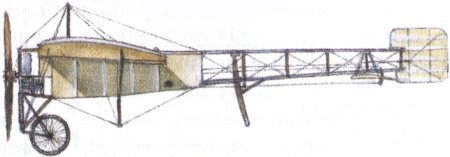А.Шепс Самолеты Первой мировой войны. Страны Антанты
"Блерио-XI", прославивший своего создателя перелетом через Ла-Манш, стал первым в мире самолетом, примененным в военных действиях. Машины этого типа принимали участие в Итало-Турецкой (1911-12 гг.) и в Балканских (1912-13 гг.) войнах. К началу первой мировой "Блерио" состояли на вооружении во Франции, Италии, Великобритании, Бельгии, Италии и Болгарии. В России насчитывалось около 50 аппаратов (из них до 30 - местной постройки), которые использовались в качестве учебных.
Для французской армии самолет выпускался в одноместном варианте (Militaire - военный), двухместном (Artillerie - артиллерийский) и трехместном (B-XI-3) вариантах. На западном фронте "Блерио" применялись в первые месяцы войны как разведчик и самолет связи, а в некоторых случаях - и для бомбометания. Ими было оснащено 6 французских и 6 итальянских эскадрилий, отдельные машины входили в 4 английских авиадивизиона. Однако появление у немцев самолетов-истребителей положило конец боевой карьере этих тихоходных невооруженных аэропланов. Весной 1915 года все уцелевшие к тому времени "Блерио" перевели в учебные подразделения.
Это был расчалочный моноплан деревянной конструкции. Фюзеляж прямоугольного сечения обтягивался полотном только в носовой части. Крыло трехлонжеронное, деревянной конструкции, обтянутое полотном. Крепление осуществлялось тремя парами растяжек из стального троса. Поперечное управление осуществлялось перекашиванием крыла. Хвостовая часть фюзеляжа не обшивалась. Руль поворота и руль высоты деревянной конструкции, обтянутые полотном. Руль поворота устанавливался на конце фюзеляжа. Руль высоты - под фюзеляжем, в хвостовой части. На самолет устанавливались различные двигатели воздушного охлаждения мощностью от 35 до 80 л. с. Самолет имел оригинальное шасси, рычажно-пружинная амортизация которого была довольно громоздкой. Вместо костыля - хвостовое колесо или две металлические дуги. Металлическими были также стойки кабины.
Выпускались также варианты на поплавковом шасси и с крылом типа "парасоль". На эти машины устанавливались двигатели Гном или Рон.
Модификации
"Блерио-ХI-2" - двухместный вариант "Блерио-XI" с двигателем "Анзани" (35л. с.). Крыло имело небольшое поперечное V. Применялся хвостовой костыль.
"Блерио-ХI-2-бис" - двухместный учебный, разведывательный и связной самолет несколько увеличенных размеров. Стабилизатор треугольный, вытянутый до задней кромки крыла. Самолет был неустойчив и труден в управлении. Двигатель "Гном" мощностью 70л. с.
"Блерио-ХI-3-бис" - трехместный вариант с двигателем "Гном" (100л. с.). Большого распространения не получил.
"Блерио-ХII" - развитие серии "Блерио-XI", но крыло сделано по схеме высокоплана вместо "среднеплана"-предшественника. Двигатели "Гном" (60 или 80 л. с.). В 1910 году несколько самолетов поступило в Россию.
"Блерио-XXI" - двухместный вариант, созданный на базе "Блерио-ХI-2-бис" с двигателем "Гном" (70л. с.).
В преддверии войны почти все машины получили дополнительное название "Милитэр" (военный). Конструкторы пытались предложить машины военным, доказывая пригодность своих машин для целей разведки.
ОСНОВНЫЕ ВОЕННЫЕ МОДИФИКАЦИИ
"Блерио-XI Милитэр" ("военный") - экипаж 1 человек, двигатель "Гном", 50 л.с.
"Блерио-XI Артиллери" ("артиллерийский") - экипаж 2 человека, двигатель "Гном" 70 л.с.
"Блерио-XI Жени" ("инженерный") - то же, что и "артиллерийский", но с усиленным шасси и видоизмененным хвостовым оперением.
ВООРУЖЕНИЕ
Не предусмотрено. В отдельных случаях на борт брали несколько мелких бомб, сбрасывавшихся вручную или с помощью самодельных приспособлений.
ЛЕТНО-ТЕХНИЧЕСКИЕ ХАРАКТЕРИСТИКИ ("Блерио-XI Артиллери")
Размах, м 10,20
Длина, м 8,25
Площадь крыла, кв.м 20,9
Сухой вес, кг 350
Взлетный вес, кг 570
Скорость максимальная, км/ч 95
Время набора высоты, м/мин 1000/14
Потолок, м 4300
Показатель Блерио-XI-2-бис Блерио-XI-3-бис Блерио-XXI Блерио-XI-2"
1910г 1911г 1911г
Размеры, м:
длина 8,25 8,50 8,24 8,50
размах крыльев 11,0 11,4 11,0 10,35
высота 2,60 2,50 2,60 2,60
Площадь крыла, м2 25,0 25,0 25 25,50
Вес, кг:
максимальный взлетный 570 610 330 585
пустого 350 380 330 350
Двигатель: "Гном" "Гном" "Гном" "Гном"
мощность, л. с. 70 100 70 80
Скорость, км/ч 85 100 90 106
Дальность полета, км 300
Потолок практический, м 1300
Экипаж, чел. 2 3 2
Вооружение 60 кг бомб
Машины, строившиеся в России по схеме "Блерио-XI"
Блерио-XI "Дукс" Гризодубов-IV Россия-Б "Люсик" Стаселя
1912г 1912г 1910г 1910г
Размеры, м:
длина 7,20 7,5 7,5 7,5
размах крыльев 8,90 7,5 7,5 7,5
высота 2,30
Площадь крыла, м2 20,9 14,0 14,0 14,0
Вес, кг:
максимальный взлетный 440 340 330 340
пустого 295 240 230 240
Двигатель: "Гном" "Анзани" "Анзани"
мощность, л. с. 70 25 25
Скорость, км/ч 90 70 70 70
Экипаж, чел. 1 1 1 1
Вооружение - - - -
В.Шавров История конструкций самолетов в СССР до 1938 г.
Из большого числа самолетов "Блерио" в России было несколько типов, один из которых строился серийно. Автор их французский конструктор и летчик Луи Блерио получил мировую известность, впервые перелетев из Франции в Англию через Ла-Манш 25 июля 1909 г. на своем самолете "Блерио-XI". За 1907-1913 гг. Блерио построил до трех десятков различных самолетов своей конструкции. Некоторые из них применялись как учебные и спортивные и до войны пользовались широкой известностью. Для военного применения самолеты Блерио были мало пригодны. Стрелкового вооружения они не имели и их применяли на фронтах недолго. К 1917 г. эти самолеты прекратили свое существование, и сам Блерио уже участвовал в создании других конструкции самолетов, в том числе самолетов "Спад".
"Блерио-XI" ("Блерио" учебный). На этом самолете многие. учились летать в 1909-1910 гг. Самолет был приобретен в двух десятках экземпляров русским военным ведомством и частными лицами. В 1910-1915 гг. он применялся в русских летных школах, под конец преимущественно как учебно-рулежный. Первоначально на "Блерио-XI" был установлен двигатель "Анзани" в 25 л. с., с которым этот самолет летал неуверенно. Потом ставились двигатели в 40 л. с. (ENV и "Лабор"), но и их мощности было недостаточно для устойчивого и надежного полета, и в том же 1910 г. на самолете был установлен двигатель "Гном" в 50 л. с. при сохранении той же конструкции. Были небольшие колебания в размерах различных экземпляров "Блерио-XI". С двигателем "Гном" в 50 л. с. эти самолеты стали называться "Блерио-XI бис".
<...>
L.Opdyke French Aeroplanes Before the Great War (Schiffer)
Deleted by request of (c)Schiffer Publishing
XI-2 Tandem: In February 1911 the XI-2 itself came in several versions. One had a lengthened nose and odd curved tailskid, another was a 3-float hydro with a tall rudder. Some had oyster-shell elevators, others had the 2-piece design. Some had half-covered fuselages like the XI, others were fully covered. Perreyon's 160 hp model had a single seat and V-leg undercarriage. But most of them were longer than the XI, with a raised cowling ahead of the first cockpit, and the tall mid-fuselage skid.
(1912: Span: 9.7 m; length: 8.3 m; wing area: 20 sqm; empty/gross weight: 300/550 kg; 70 hp Gnome)
(1913: Span: 10.35 m; length: 8.4 m; wing area: 19 sqm; empty/gross weight: 335/585 kg; top speed: 115/120 kmh; 80 hp Gnome)
XI-2 Type Genie (engineer): Similar to the XI-2, the April 1912 70 hp Gnome Genie had an odd horizontal tail unit set on struts below the aft fuselage, with a one-piece elevator with an S-curved trailing edge. The rudder did not hang below the tailpost, and the bottom rear corner was clipped to allow for the elevator below it. The 2 cockpits were separated; the cabane was now a 4-strut pyramid, and the tailskid was the single high design aft of the rear cockpit. The fuselage of the machine used for the Circuit d'Anjou race was fully covered.
(Span: 9.7 m; length: 8.3 m; wing area: 18 sqm; empty eight: 320 kg; loaded weight: 550 kg; speed: 110-115 kmh; 70 hp Gnome)
XI-2 Type Hauteur: Powered with the 80 hp Gnome, this one was used by Roland Garros in his altitude flights in August 1912 and March 1913. With a 4-strut pyramidal cabane, it stood on a V-leg undercarriage. The machine used in the later attempts had a fully covered fuselage; in June a similar machine with 2 seats beat Garros' records.
The famous stunt-flier Pegoud used at least 3 different XIs. His most famous achievement, the first loop, was in 1913 inahalf-Bleriot, half-Borel machine with a 2-piece elevator and a single inverted-V pylon. His experiment with a parachute attached to the top of the fuselage in 1913 was in another XI with a V-leg undercarriage and the tip elevators of a much earlier period. A third one appeared with the high tailskid set shortly behind the cockpit.
The Type XI in its various forms, and some of the later models as well, served until 1915 when the monoplane design fell into disfavor. Bleriot joined the Spad firm (la Societe Provisoire des Aeroplanes Deperdussin), and became its president. When Armand Deperdussin was disgraced for his financial misdealings, Bleriot absorbed the firm, becoming president and changing its name to la Societe pour l'Aviation et ses Derives, with Bechereau as chief engineer. After the war, Deperdussin committed suicide.
Bleriot now concentrated on building Spads, and with the designer Herbemont, racing aircraft; he also built a 26-passenger 4-engined transport in 1919. The firm diversified as well, into motorbicycles, boats, and knock-down furniture. Back into aircraft, he produced pursuit and heavy transport designs. Bleriot died on 1 August 1936, and on 20 March 1937 his factories were nationalized.
O.Thetford British Naval Aircraft since 1912 (Putnam)
BLERIOT TYPE XI
Fundamentally similar to the aircraft used by Louis Bleriot for his historic crossing of the English Channel in 1909, this type was used by both the Naval and Military Wings of the RFC and subsequently by the RNAS from 1912 to early 1915. One 80 hp Gnome engine and a loaded weight of 1.388 lb. Maximum speed, 66mph at sea level. Climb, 230 ft/min. Span, 34 ft 3 in. Length, 27 ft 6 in.
M.Goodall, A.Tagg British Aircraft before the Great War (Schiffer)
Deleted by request of (c)Schiffer Publishing
BLERIOT AERONAUTICS (Louis Bleriot, Belfast Chambers, 156 Regent St., London, W. Flying School & Works at Hendon and Brooklands)
After Bleriot's Channel crossing in July 1909 in his Type XI monoplane, a number of similar machines were made by various firms and individuals, mostly without approval by Bleriot. A Bleriot School was established at Hendon on 1 October 1910, and in 1914 sheds were taken at Brooklands and enlarged to provide offices and manufacturing facilities, all under the control of M. Norbert Chereau, Bleriot's manager for Great Britain.
The RFC used various types of Bleriot monoplanes operationally prior to and in the early months of the war, but these were soon relegated to training duties. The majority of Service aircraft were probably French made, but the British company received contracts for the Type XI single-seater, the Type XI-2 two-seater and the single-seat parasol version of 1914. Deliveries of these continued well into 1916, by which date the works were in the process of being transferred to new premises at Addlestone, Surrey.
The quantities of Type XI and XI-2 aircraft made in Britain is uncertain, but it is recorded that at least fourteen parasols Serial Nos.575-586 and 2861-2862 were made at Brooklands.
Bleriot Type XI-2 monoplane
Power: 70 or 80hp Gnome seven-cylinder air-cooled rotary.
Data
Span 34ft
Length 27ft 6in
Area 205 sq ft
Height 8ft 2in
Weight 738 lb
Weight allup 1,290lb
Max speed 75 mph (80hp)
Endurance 3 1/2 hr
Jane's All The World Aircraft 1913
BLERIOT Monoplanes. L. Bleriot, "Bleriot-Aeronautique," 39, Route de la Revolte, Paris-Levallois. Flying grounds: Buc Etampes and Pau.
L. Bleriot began to experiment in 1906, along Langley lines. By 1909 he was one of the leading French firms; and the first cross Channel flight was made by him.
Details of standard types:--
XI bis. XXI. XXVII. XXVIII. XXVIII. Monocoque
2-seater Military Single Single 2-Seater 2-Seater
mono side by seat seater
(1911 side mono. 1913. 1913. 1913.
onward) 2-seater 1912.
mono. 1912
Length....feet(m) 27(8.40) 27? (8.24) 28 (8.5) 25 (7.60) 27 (8.20) ...
Span......feet(m) 36 (11) 36 (11) 29? (9) 29 (8.80) 32 (9.75) 40(12.25)
Area..sq.ft.(m?.) 349 (33) 268 (25) 129 (18) 162 (15) 215 (20) 270 (25)
Weight, unladen...
........lbs.(kgs) ... 727 (330) 529 (240) 530 (240) 660 (300) 830 (375)
Weight, useful...
.......lbs.(kgs.) ... ... ... 286 (129) 550 (250) ...
Motor.......h.p. 50 Gnome 70 Gnome 70 Gnome 50 Gnome 70 Gnome 80 Gnome
Speed,max...
.......m.p.h.(km) 56 (90) 56 (90) 78 (125) 62 (100) 71 (115) 75 (150)
Endurance...hrs. ... ... ... ... ... ...
Number built
during 1912 ... ... ... ... ... ...
Note.--The monos., as usual, are of wood construction; wheels only for landing. Rectangular section bodies. Warping wings, elevator in rear. Chauviere propeller. The monocoque has wood, steel and cork construction. Coque body. Skids to landing chassis. Levasseur propeller. Otherwise as the other monos.
Principal Bleriot flyers are or have been:--Aubrun, Balsan, Bleriot, Busson, Chavez, Cordonnier, Delagrange, Drexel, Efimoff, Gibbs, Hubert, Hamel, Moissant, Paulhan, Prevetau, Prevot, Prier, Radley, Thorup, Tyck, Wienzciers, and many others.
J.Forsgren Swedish Military Aircraft 1911-1926 (A Centennial Perspective on Great War Airplanes 68)
Bleriot XI
Almost inevitably, a small number of Bleriot XIs entered service with the AFK. The first two were bought in December 1913 from Skandinaviska Aviatik AB (a company controlled by Carl Cederstrom), both being taken on charge January 7, 1914. Powered by 24 and 35 h.p. Anzani engines respectively, these Bleriot XIs were used at Malmen as non-flying taxiing trainers. Neither of them received a serial number, with both being struck off charge in December 1916.
Following outbreak of war, three Bleriot XIs were purchased on August 8, 1914 from civilian owners. All were powered by 50 h.p. Gnome Omega rotary engines. The first of these was an AVIS-built Bleriot XI, being serialled 7. After being struck off charge in November 1916, this Bleriot XI was sold to AETA, eventually emerging as Thulin A s/n A8. In this context, mention must be made of Enoch Thulin’s company AETA, which during the fall of 1914 had begun building the Bleriot XI under licence as the Thulin A. Thulin appear to have expected the AFK placing a substantial order for Bleriot XI/Thulin As, something which, in the event, never materialized.
The second Bleriot XI had been built in 1912 for Skandinaviska Aviatik AB. Following arrival in Stockholm, the airplane was assembled by Wiklunds Maskinfabrik, being air tested on September 3,1912. Already in October 1912, the Bleriot XI was sold to the magazine publishers E. Akerlund and J.P. Ahlen. Initially named Ugglan (The Owl), the airplane was renamed in July 1914 as Vecko-Journalen (the name being one of the magazines published by Ahlen & Akerlund). In May 1914, AVIS had refurbished the airplane, which was then air tested by Enoch Thulin on June 6, 1914. After being taken on charge by the AFK as serial number 11, it was used at Malmen as a primary trainer. It was struck off charge in November 1916.
The third Bleriot XI had originally been bought in France in 1911 by Carl Cederstrom. Apparently, the airplane was ’’strengthened for loopings”. Arriving in Stockholm on May 11, 1911, the airplane was assembled by Wiklunds Maskinfabrik. Following an air test on May 20, the Bleriot XI was named Nordstjernan (Northern Star) by Cederstrom. Used extensively by Cederstrom for exhibition flying tours around Norway and Sweden, the airplane was sold to Enoch Thulin and Tord Angstrom on June 5, 1913, with Thulin becoming the sole owner two-and-a-half months later, on August 15. Following purchase by Thulin and Angstrom, the airplane underwent and extensive refurbishment, involving the replacement of the fuselage and wings.
After being taken on charge by Flygkompaniet in August 1914, the serial number 13 was assigned to the airplane. Following a crash in September 1915, the Bleriot XI was rebuilt, and issued with a new serial number; 17. On November 21, 1916, it was written off in a crash at Silows kulle (Silow’s hill, the place of Carl Silow’s fatal crash on May 1, 1915). Seemingly a case of having nine lives, the remains of the Bleriot XI was sold to AETA, subsequently reemerging as Thulin A s/n A9.
Additionally, one Bleriot Big Bat (possibly built in Great Britain), was offered to AFK in August 1914 by its owner, Filip Bjorklund, but rejected. In February 1915, Bjorklund sold his Bleriot to Denmark.
Bleriot XI Technical Data and Performance Characteristics
Engine: 1 x 50 h.p Gnome rotary engine
Length: 7,5 m
Wingspan: 8,85 m
Height: 2,7 m
Wing area: 14,00 m2
Empty weight: 320 kg
Maximum weight: 400 kg
Maximum speed: 80 km/h
Armament: -
J.Davilla Italian Aviation in the First World War. Vol.2: Aircraft A-H (A Centennial Perspective on Great War Airplanes 74)
Bleriot 11
The Italian Aviazione Militaire (Air Service) purchased five Bleriot 11s in 1910. These were:
1. 50-hp Gnome - one two-seater and one single-seater.
2. 35-hp Gnome - one single-seater.
3. 25-hp Gnome - two single-seat trainers.
Italian Variants
The Italians used five main types of Bleriot 11s, all built under license by Oneto di Pisa and S.I.T. (the Societa Italiana Transaerea = Italian Transaerial Society). S.I.T was part of the Bleriot company created by them at Turin. The sixtieth and last model was tested on November 20, 1915.
1. Bleriot 11 “Monoposto” - a single-seater with a 50-hp Gnome engine. It was soon discovered to be of little use in wartime.
2. Bleriot 11 with low power (30 to 45-hp) Anzani engines. These were also too underpowered for combat service, but proved to be excellent trainers.
3. Bleriot 11 “Parasol” - 70-hp Gnome; this saw widespread use with the squadriglias. Eight were built in France, but were soon found to be of limited use. Approximately 47 were built by S.I.T.
4. Bleriot 11 “Idro” - seaplane version of the 11 with a 90-hp Le Rhone engine, twin floats and a tail float. Only one example was produced.
5. Bleriot 11-2 - a two-seater with an 80-hp Gnome engine. It was used for reconnaissance and bombing, as well as training.
There were also underpowered versions (likely created from the Anzani powered versions) used as “penguins” to familiarize students with aircraft handling without actually being able to take off.
6. Bleriot “Biposto” - Unlike the Bleriot 11 designs, the “biposto”was a conventional biplane with tail booms and cockpit with a pusher engine. It was two-seater equipped with an 80 hp Gnome rotary engine. The aircraft was built in 1913 by Louis Bleriot, breaking a tradition that was the standard bearer of the monoplane, built the aforementioned biplane which appeared at the Paris International Air Show that same year.
The aircraft closely resembled a Henri Farman H.F.20 apart from the simplified landing gear (no skid) and more rounded wing tips. The biplane remained a prototype state presumably the French were satisfied with the Farman design.
S.I.T. was owner of the Bleriot patents in Italy and in 1914 acquired the aircraft which they designated “Biposto” to evaluate in Italy.
No further examples were purchased.
7. SIA-Bleriot - These were eliminated by the military prior to the start of the 1912 competition. They were an all-metal biplane version of the Bleriot 11. It was designed by Ing. Alberto Triaca with an 80-hp Gnome engine. A total of 77 examples were built by S.I.T., alone. Italian production brought the number of Bleriot 11’s acquired up to 221.
Operational Service
Bleriot Ils of various types were sent to the aviation scuole (school) at Centocelle in Rome), which ceased operations on March 11, 1911. The Bleriots were then sent to the schools at Malpensa and Aviano.
The aircraft found a more warlike role when they served as reconnaissance aircraft during the Monferrato maneuvers the week of 22 August, 1910. At least 12 aircraft were used during the maneuvers; they were a mix of 50-hp single-seaters and 70-hp two-seaters.
Two were assigned to the Flottiglia Aeroplani (Airplane Fleet) as part of the expedition to Libya. They reached Tripoli on 15 October, and on the 24th capitano d’artiglieria (artillery captain) Carlo Piazza made what is widely regarded as the world’s first combat sortie by an airplane, a one-hour reconnaissance flight; he later damaged his Bleriot on landing.
A two-seater and two 80-hp single-seaters also equipped the Tobruk squadron from March 1913, which was repatriated on 12 August.
In the following days, the Italians experimented with a variety of ways to use these aircraft, including missions at night (March 4,1912). They served alongside Nieuport 4s as part of the 1st Flottiglia di Aeroplani de Tripolia, which consisted of nine machines that undertook reconnaissance, bombing, and even leaflet-dropping operations during the Turko-Italian War.
A lists of firsts during the war in Libya include;
- first combat sortie on 22 October 1911
- first adjustment of naval fire on 28 October 1911
- first photographic reconnaissance on 23 February 1912
- first night combat sortie on 4 March 1912
In 1912 the Bleriot 11 was included among the types chosen for incorporation into the newly re-structured the air forces.
The next year SIT of Turin delivered 33 30-hp two-seaters followed by other variants in 1914 and 1915. Also, the first Bleriot 11-2 two-seaters were at last obtained from France in March 1912. Two-seaters were needed due to the observation, during the type’s deployment to Libya, that the pilot’s workload during reconnaissance missions was high enough to warrant carrying a second crew member.
In 1913 the following Squadriglias used Bleriot 11s:
1a Squadriglia (based in Turin-Mirafiori) 2a Squadriglia (Turin-Venaria Reale)
3a Squadriglia (Cuneo)
4a Squadriglia (Rome-Centocelle)
13a Squadriglia (Piacenza),
14a Squadriglia (Brescia)
Tobruk Squadriglia - one Bleriot 11-2 and two single seaters (possibly Bleriot 11 “Parasol”).
Ideally each Squadriglia would have five operational aircraft and two more in reserve.
When a Bleriot 11 crashed at Mirafori on 24 April 1914 after its wings detached, the military issued a flight ban while the airframes were examined.
First World War
When Italy entered the war there were 30 Bleriot 11s (plus seven in reserve) available. This does not include aircraft serving in the Aviano and Miraflori Schools.
The Bleriot 11s were with 1a, 2a, 3a, 4a, 13a, and 14a Squadriglias. They were assigned as follows:� 1st Gruppo: 1a, 2a, 3a, 13a, and 14a Squadriglias.
3rd Gruppo: 4a Squadriglia.
In 1915 the 1st Gruppo was assigned to the 3a Armata while the 4a Squadriglia was attached to the Venice Fortif Harbor Headquarters.
Thirty Bleriot Ils were assigned to the front but had be withdrawn as being unuseable by 1 December 1915, 2a, 5a, and 13a Squadrilias being the first to disband.
After their retirement form operational units, the surviving Bleriot Ils were relegated to training roles.
S.l.T.-built Bleriot 11 Parasol with 70-hp Gnome engine
Wingspan 9.20 m; length 7.80 m; height 2.95 m; wing area 18 sq. m
Empty weight 310 kg; loaded weight 480 kg Maximum speed: 110 km/h
S.l.T.-built Bleriot 11 Idro Floatplane with 90-hp Le Rhone
Wingspan 11.05 m; length 9.00 m; height 3.0 m; wing area 24 sq. m
Empty weight 500 kg; loaded weight 740 kg
Maximum speed: 95 km/h
One built
S.l.T.-built Bleriot 11-2 (Italian) Two-Seat Reconnaissance Plane with 70/80-hp Gnome
Wingspan 10.30 m. length 8.40 m, height 2.45 m (Alegis states 2.60 m), wing area 20.3 sq. m
Empty weight 345 kg; loaded weight 585 kg; payload 240 kg
Maximum speed: 95 km/h; endurance 3 hr 30 min; climb to 1,000 m in 18 minutes; climb to 2,000 m in 50 minutes
Armament Winchester carbines for the crew, flechettes, and bombs
47 built
Bleriot Biplane
Wingspan, 12.70 m; length, 9.15 m; height, 3.10 m; wing area, 38 sq m
Empty weight 400 kg; loaded weight 650 kg; payload, 250 kg
P.Grosz, G.Haddow, P.Shiemer Austro-Hungarian Army Aircraft of World War One
Bleriot Monoplanes
During the war, two or three Bleriot monoplanes were operated as primary trainers. One unnumbered machine, Bleriot IX w/n 931, was still flying as late as October 1918 at Flugpark 1.
Журнал Flight
Flight, April 22, 1911.
LONDON TO PARIS NON-STOP BY AEROPLANE.
TRULY can it be said that aviation history is being made at a marvellous rate, and it would seem that record cross-Channel flights are to mark the periods of that history. The year 1909 saw the famous flight of M. Bleriot from Calais to Dover. In 1910 the late Hon. C. S. Rolls made the double journey from Dover to Sangatte and back without a stop, while 1911 is likely to be remembered as the year in which Pierre Prier improved on the records by flying from London to Paris without breaking his journey. It is true the late Mr. J. B. Moisant succeeded in covering the space between the French and English capitals last year by way of the air, but it will be remembered that he made numberless stops - albeit they were unwilling ones - on the way, while his journey occupied a good many days owing to difficulties encountered on this side of the Channel. Not only is M. Prier's trip a record for cross-Channel work but it is also a world's record for a cross-country flight from point to point. That it should be possible for an aviator to set off at practically a moment's notice on a journey of 250 miles without making any very elaborate preparations is an extraordinary commentary upon the progress in aviation which has been accomplished during the past year. It is, in fact, what happened, for although the aviator had been thinking over the possibility of making such a trip for six weeks, the recent spell of bad weather had necessitated the temporary abandonment of the project. On Wednesday of last week, however, M. Prier was giving M. Norbert Chereau a trial run on one of the new Bleriot monoplanes at Hendon, when it was suggested that the conditions were favourable for a flight to Paris. The suggestion was acted on forthwith. M. Prier had his cross-Channel flyer brought out, got into readiness, and by a quarter-past twelve was in the air. When he had travelled only a little way, however, he found it was practically impossible to keep up the pressure in his petrol tank, and so returned to the aerodrome for this to be remedied, after having been in the air for about half an hour. At 1.30 p.m. the adjustments were completed, and at 1.37, to be exact, M. Chereau timed the aviator away for his journey to Paris.
Following a route which had been carefully prepared beforehand on a roller map, which was arranged in front of the pilot, the aeroplane winged its way round the suburbs on the north side of London, and then working eastward of the Metropolis, followed the Thames to Chatham, turning southward when past Canterbury, to Dover. From here, M. Prier steered across the Channel to Cape Grisnez, on reaching which point he turned and followed the coast to Boulogne, arriving there at 3.15, as he was more familiar with the landmarks on the route between there and Paris. Continuing his journey onwards to Abbeville and Beauvais without incident, he crossed the French capital, which was so enshrouded in mist that even the Eiffel Tower was not distinguishable, and sighting Issy, came down in front of the Bleriot sheds there at 5.33 p.m., being warmly welcomed by M. Louis Bleriot himself. Throughout the journey the Gnome-engined Bleriot behaved splendidly, and M. Prier had no difficulty in finding his way by the aid of the special map and a compass. When Hendon was left the wind was blowing slightly from the north-east, but at Dover it had veered to north-west. The only difficulties experienced were due to the mists passed through in England and a bank of fog encountered near Beauvais. The actual time taken for the trip of 250 miles was 3 hrs. 56 mins., so that the average speed maintained was in the neighbourhood of 64 miles an hour. During most of the journey M. Prier was at a height of about between 2,000 and 3,000 feet.
Flight, June 10, 1911.
PARIS-ROME-TURIN.
IN our last issue were just able to briefly announce that "Beaumont" was the first to actually arrive at Rome on Wednesday of last week. He made a magnificent flight from Nice, after having had a new motor fitted to his machine, A quarter of an hour's trial flight was indulged in as soon as the mechanics had finished their work, and then he set off at 3.57 a.m. He landed at Genoa at 6.47, and an hour later started off once more for Pisa, where he arrived at 9.40, landing on the horse racecourse in error. Realising his mistake, he afterwards restarted the machine and flew over to the proper aerodrome, where he landed an hour later. At ten minutes past twelve he left for Rome, and landed in the precincts of the Eternal City at eight minutes past three, his passage over the city being witnessed by His Holiness the Pope and Cardinal Merry del Val from a balcony of the Vatican.
Garros made a move from Pisa at 4.35 a.m., but had only progressed 60 kiloms. on his journey when he was forced to make a landing at Castagneto-Carducci. In coming down very suddenly from a height of 200 metres the machine was very badly smashed. Frey continued his journey from Genoa to Pisa, but in alighting at the latter place smashed his propeller and also damaged the chassis of his machine. Of the other competitors, Vidart advanced from Avignon to Nice, while Bathiat was brought down by motor troubles at Macon, after covering the 110 kiloms. from Dijon in 54 mins. Lieut. Lucca succeeded m getting from Lyon to Avignon
Flight, September 2, 1911.
AIR EDDIES.
Hendon habitues will be glad to hear that Frank L. Champion, who will be remembered by Hendonites as that delightfully droll "Candy Kid" who came across from Southern California to graduate at the Bleriot School, is doing really well out West at Los Angeles. He is now flying a Gnome-Bleriot, the machine purchased from Radley by Earle V. Remington at the Los Angeles aerodrome. In order to demonstrate to a Long Beach committee his ability to give exhibitions at the forthcoming midsummer carnival, Champion flew there from Los Angeles, a distance of roughly 20 miles, and circled over the town at a height of 1,500 feet. It is hardly surprising to hear that as a result of his flight, which, by the way, was his first since his return to the States, he has been engaged to fly at the Long Beach Carnival festivities. Since then he has succeeded in falling into the sea - accidentally, or for advertisement's sake, we wonder! That aviators are drawn from all sources is pretty well known. Champion formerly carried on a photographer's business at Long Beach.
Flight, September 9, 1911.
NEW WORLD'S RECORDS.
Garros Creates New Altitude Record - 13,943 ft.!
STILL the competition for the altitude record goes merrily on Lincoln Beachy's height of 11,578 ft. made at Chicago has now been put in the shade by the extraordinary performance of Garros, who on Monday, in the neighbourhood of St. Malo, went up on a Bleriot monoplane to a height recorded by his barograph as 4,250 metres, or 13,943 ft., subject to official recognition. The previous French record, and a world's record previous to Beachy's flight, was the 2,350 metres reached on August 5th by Capt. Felix.
Flight, October 7, 1911.
FROM THE BRITISH FLYING GROUNDS.
Portholme Aerodrome, Huntingdon.
ON Friday of last week some flying was seen at these grounds, when Mr. W. B. R. Moorhouse took the pilot's seat of his Gnome-Bleriot for the first time. He got off in 20 yards, and flew four times round the drome at an average altitude of 200 feet, his aneroid in one instance registering 300 feet. He finished up with a very neat landing, not bumping in the least. His success speaks well for Mr. Moorhouse's future, as it was his first attempt with a Gnome-Bleriot, and he had had but a very little previous practice with an old Anzani-Bleriot, which was available last year. On Saturday it was raining and blowing a couple of gales lashed together, and flying was out of the question,
Flight, October 14, 1911.
FROM THE BRITISH FLYING GROUNDS.
Portholme Aerodrome, Huntingdon.
MR. W. B. R. MOORHOUSE, after his essays the previous week, was last week making a series of remarkably successful flying trips. On the Monday, he, on his Gnome-Bleriot with Chauviere propeller, made four good flights in the morning, travelling well outside the aerodrome, in the afternoon putting up a further five flights, again outside the aerodrome, keeping well up at above 2,000 ft. or so. The next day he flew from Huntingdon to Northampton, accomplishing the distance (45 miles) in the half-hour, most of the time being at an altitude of fully 3,000 ft. Mr. Moorhouse is a fearless flyer, and merely took in Northampton, having steered there via Bedford, Turney and Yardley Hastings on route, during a visit to his parents' house, Spratton Grange, a few miles northward of Northampton. This was Mr. Moorhouse's first cross-country flight, and the machine he was using was the identical Bleriot on which Mr. Morison not so very long ago took a dip into the Channel near Folkestone. On his return journey to Huntingdon Mr. Moorhouse again passed over Huntingdon, and continued on by Wellingborough and Kettering, reaching Portholme at 3.5 p.m., having started a little after 2 p.m. from Spratton. On Wednesday and Thursday work was in progress on the new Radley-Moorhouse monoplane, but on Friday Mr. Moorhouse resumed his cross-country work by flying from Huntingdon to Northampton, where, after partaking of lunch, he struck out again for Brooklands, encountering en route some extremely gusty winds and fogs, although he rose to a height of 4,000 ft. to get away from this trouble. Saturday afternoon, testing was again the chief work on the R. and M. monoplane, which appears to be working very successfully, as he, during the day, was up on the machine and actually passed for his certificate on it. Mr. Morison subsequently had a flight round in the new machine and appeared to be well satisfied with its behaviour.
On Tuesday evening last Mr. Moorhouse left Brooklands in his Bleriot for Huntingdon, but running short of petrol near Cambridge, he came down at Parkers Piece, having made a magnificent gliding descent commencing at about Trumpington, two miles south of Cambridge. He flew on to Huntingdon on Wednesday morning at 6.30 a.m.
Flight, November 11, 1911.
AEROPLANES AT TRIPOLI.
MR. QUINTO POGGIOLI, who will be remembered by our readers as having taken his pilot's certificate in England under the Royal Aero Club's regulations, sends us some interesting details of the practical work being carried out in Tripoli in connection with the Italian-Turkish War. Mr. Poggioli writes :-
"On the 25th Oct. Capt. Piazza with his Bleriot, and Capt. Moizo on his Nieuport, observed three advancing columns of Turks and Arabs of about 6,000 men. The Italians, after receiving this information, could successfully calculate distances and arrange for their defence.
"On the day following, the 26th Oct., the battle of Sciara-Sciat took place, resulting in the loss to the Turkish Army of 3,000 men. During the battle two aeroplanes, Lieut. Gavotti with his Etrich and Capt. Piazza, were circling the air. The flights took place above the line of fire, so as to be able to direct the firing of the big guns from the battleship 'Carlo Alberto,' and also of the mountain artillery. The aeroplanes were often shot at by the guns of the enemy, but with no result. The only difficulty they had was caused by the currents of air caused by the firing of the big guns.
"Previously, on the 22nd Oct., Capt. Moizo when reconnoitering passed over an oasis, and, in order to observe better the movements of the enemy, descended to an altitude of about 200 metres, and in consequence the wings of his machine were pierced by bullets in six or seven places, and also a rib was broken.
"On November 1st Lieut. Gavotti (Etrich) flew over the enemy, carrying four bombs, carried in a leather bag; the detonator he had in his pocket.
"When above the Turkish camp, he took a bomb on his knees, prepared it and let it drop. He could observe the disastrous results. He returned and circled over the camp, until he had thrown the remaining three bombs. The length of his flight was altogether about 100 kiloms.
"The bombs used contained picrato of potassa, type Cipelli."
THE first official communication by one of the belligerents, in regard to the use of aeroplanes in actual warfare, has been issued by the Italian authorities, dated November 5th, from Tripoli. As a matter of historical record we reproduce the text in extenso as follows :-
"Yesterday Captains Moizo, Piazza, and De Rada carried out an aeroplane reconnaissance, De Rada successfully trying a new Farman military biplane. Moizo, after having located the position of the enemy's battery, flew over Ain Zara, and dropped two bombs into the Arab encampment. He found that the enemy were much diminished in numbers since he saw them last time. Piazza dropped two bombs on the enemy with effect. The object of the reconnaissance was to discover the headquarters of the Arabs and Turkish troops, which is at Sok-el-Djama."
Flight, November 18, 1911.
Aeroplanes in War.
THE Italian Army in Tripoli are now using three Bleriot monoplanes which have been in use in Italy for some time, one of them being flown by Captain Piazza, who is the Commander of the Aviation Section, and who will be recaused, membered as being the winner of the Italian Circuit during last summer (Bologne-Venise-Rimini and Bologne). The Italian Government has placed a further order for three more Bleriot monoplanes, and Captain Anostini is now at Etampes to see the trials of the machines, which are to be delivered this week.
Flight, December 30, 1911.
PARIS AERO SHOW.
L. Bleriot.
FOUR monoplanes are on view on this stand, the 70-h.p. two-seater, which Hamel has popularised in England, the familiar 50-h.p. cross-country model, a new 50-h.p. racing monoplane, and a new low horse-power monoplane, type XXVIII, designated the "Popular" type. Of these machines we are already familiar with the former two, and no description of them is necessary.
<...>
Principal dimensions, &c. :-
Cross-country type-
Length 25 ft.
Span 29 "
Area 165 sq. ft.
Weight 528 lbs.
Speed 60 m.p.h.
Motor 50-h.p. Gnome.
Price L860.
Flight, March 2, 1912.
Mr. Hewitt has a Rough Landing.
ON Saturday last Mr. Vivian Hewitt started on a flight with his Gnome-Bleriot from the Foryd Aerodrome, Abergele but when only about 100 feet up the petrol pipe broke and the engine stopped. He was just leaving the aerodrome at the time and had no chance to turn into it. The machine did a tail slide, then pancaked and afterwards started gliding. By that time he was only about 30 feet up and after hitting a ditch and bouncing along frightfully uneven ground the machine pulled up at the edge of another ditch. Fortunately nothing was broken, but it was necessary to dismantle the machine to get it back to the aerodrome.
Flight, March 16, 1912.
MY PARIS FLIGHT.
By HENRI SALMET, Chief Instructor of the Bleriot School, Hendon.
FOR some time past I have wanted to fly to Paris and back in one day, and also, as I should like to see M. Bleriot in Paris about business matters. I think, it being fine, on Thursday the 7th, I will go. The night before I paint on the wings of my Bleriot some varnish that keep the fabric tight and make it waterproof, and later I telegraph to the coastguard at Eastbourne to telephone me in the morning if the weather is good. Next morning early the message arrive. The coastguard say the Channel is clear of fog, so I get ready. The fuselage of my Bleriot had already been covered in with fabric and waterproofed so as to make a float and keep me up if my engine fail and I go in the water. Round me I put an inner tyre from one of the school machines which I blow up. I run my engine and it go very well, so I wave my hand and I am away.
When I left here it was exactly 7.45, with little wind behind me. The wind increased, and after about a quarter of an hour the wind was much more stronger, and my speed was about half as much again. At Eastbourne I was 1,200 metres high and about 2 miles over the sea, but the wind was too gusty. I came back, and I took 3,000 ft. more high, and that took me 13 mins. After that, I started again on my way to Paris, and I flew for 1 hr. 40 mins. without seeing anything other than the clouds. The sight at that height was most marvelous - I think absolutely the best something I have seen in my life. At that height the clouds were more like big snowy mountains, and flying through them was the most curious experience that could happen to anyone. A glance behind showed my wake in a swirl of fog disturbed by the propeller and the passage of the machine. So cold was it in the clouds, that I had constantly to increase my high so that I could get above them. This brought me to a height of between 6,000 and 7,000 ft., and as I could not see the sea, steering had to be entirely done by compass. This was hard to do, for the wind, although fairly steady, set the monoplane rolling slowly, and the compass needle kept swinging continually about ten degrees each side of the true line. This had to be accounted for. From points that I had recognised over English soil, I calculated that my speed was something over 130 kiloms. an hour, and from the time I got my last glimpse of the earth, I flew for 1 hr. 40 mins., and then from my speed calculated just about where I ought to find myself. Here I thought I ought to descend, as I wanted to make sure that my compass was guiding me correctly, and that I was on my right way.
For a long time I see nothing but the wings of my machine. I came down to 200 metres in order to distinguish points that I wanted to find. Then I flew round in big circles for 17 minutes, at last recognising a castle that I had marked on my map. Picking up the adjacent railway line, I reached Gisors. Here it was clearer, and I gradually elevated to 2,000 metres. Although it was possible to distinguish land marks, I did not look down once as I was so occupied in fighting the gusty wind that I did not trouble to do so, knowing full well my compass was steering me correctly. I saw the Eiffel Tower after a long struggle, and the sight gave me very big pleasure because it is the first cross-country flight I have make. I see Issy from 1,500 metres, and commenced my vol plane.
To battle against the remous caused by the big houses, I have to descend very steep to keep up my speed. Gusts rapidly struck me from below, and had I not gripped the cabane with all my might deserted because I arrived before my telegram. On landing I took from my machine the little can of paraffin I always carry, and washed over the engine - my good engine, which had brought me all the way from London without any trouble. All the more pleasure because I myself look after the engine, no one else touch it. Then I go to find someone, and I find a guardian of the aerodrome with a mechanic from the Astra Company, and I asked him "Where are the Bleriot hangars?" and he say "Opposite there." As I turned to go to the sheds he say to me "Can you tell me any news of the English aviator who should fly from London to Paris?" and I say "The English aviator is me." Then we shake hands. Then he say "If you are the English aviator you speak French very well indeed. What is your name?" and I said "Henri Salmet of the Bleriot School in England." Then I go to the Bleriot sheds and get the mechanics to fetch my machine and put it safe in the hangar. I ask for M. Bleriot's telephone number to ring him up and tell him I arrived. I telephone and he speak himself, and he say "Why do you not send a telegram?" At that moment the telegraph boy must have come into his office, for he say "the telegram has just arrived now." I say "When can I see you M. Bleriot?" and he say "I see you about three or four " but I reply "I shall be far off by then." He say "Why?" I say "Because I want to get back to London to-day." Then he came down to Issy in a car with M. Leblanc, and some reporters.
M. Bleriot seem very please. He say "Bon jour, Salmet. Toutes mes relicitations! Par on avez vous passe." I say that I had come by the way I had chosen, and that I had tell him some time before. He is very happy that I do cross the channel at the wide part, from Eastbourne to Dieppe - thing that had not been done since aviation existed. In his great joy he grasp my both hands, and squeeze so hard that he hurt much. And M. Leblanc also. Then we have lunch at the Cafe Syndicat des Aviateurs. They say to me, there is too much wind, and you cannot return. But I did not pay attention to that, as no matter what the struggle I had big confidence in my Bleriot, my Gnome, and my wonderful Levasseur propeller, which give so much pull and runs so smoothly. It is the best I have try. With my three faithful friends, my machine, my motor, my propeller, the wind have no fear for me. So at 2.15 with the anemometre at 34 kilometres to the hour, I start once more. The start is not alone, because the ground is used by the soldiers, but I go to ask at the Commandant to let me start. He say "Yes, with pleasure," and he took his soldiers in a good place to give me plenty of room, and I go. I start straight on my line, but the ground is not much large and when I am over the houses I am very low, and the wind put me sometime in very bad situation. I am very long to take my high, because sometime I am 200 metres up, and then I come down again with the wind.
After I have crossed the Seine I have less remous, and I go more high. Since this time the wind is much more regular, but so strong that I take nearly four hours to make 220 kiloms. I am very cross against the weather, because I am obliged to land at Berck Plage with my petrol tank nearly empty.
As soon after my landing I start to find petrol. That take me too long time, and after that it is too late to start. I had wanted very much to sleep on English ground that night. A friend help me find petrol and oil, and after filling the tanks, I go to take something to eat with him. As he knew I wanted to start early next morning, he locked me in my bedroom that night, so that I should not go without him seeing me. At five o'clock he come in my room and give me a good cup coffee. I took it, and soon after I go with him to where the machine is tied up. I give a little exhibition fly, and land on the shore. Then before they let me go I have to sign many postcards, and many people take photographs of the machine.
Starting again just before ten, the wind was blowing about 32 kiloms., and was a little foggy. I fly for two miles, and my engine start missing. My magneto is wrong. I put it right, and I start again at 10.12. Then I go across the Channel from Cap Grisnez to Folkestone very fast indeed. I am across the other side in fifteen minutes, and there the wind come more badly. Having no map, and as the compass rock very badly, I keep over the main road. The wind and rain beat very hard in my face. I don't like to land because I like to put my machine in my shed at Hendon before landing anywhere. But the wind and rain coming always more strong, I think it more wise to land than to continue. It take me a quarter of an hour to go four miles. Then, seeing a good landing ground on my left, I come down, and find I am at Chatham. If I am very cross against the weather I meet there the best people I have ever met. All people is ready to help me for anything. They all want to give me something to eat. I go with Mr. Sills, who has a room where I can be quiet, for I am very tired after the struggle. The schoolmaster there makes a meeting in my honour, and I go there in the evening, and they give me a big tri-colour bouquet, and after much shouting I have to sign many postcards.
The next morning I start at 6.15 in a very bad wind towards London. My cloche is always moving; but all is well until I fly into some fog. I remember the Regent's Park happening, and I think it better to descend than to continue and land in some place where the Aero Club would not like it. Near Maidstone I have to land in a champ labore, and I break a piece off my propeller. My good friends from Hendon soon bring me another one, and we put it on. The weather is not favourable to start, but I am so hurry to come to Hendon that I look with a bad eye at those who say the weather is too bad. I go on again; but soon after my motor stopped, and I have to descend in a football field near Beckton gasworks. I land very deep from 800 metres, because ground is small. I see I am going to hit a goal-post, so I pull lack my cloche to clear it. My speed slackens as I rise, and a gust comes and blows me right over. I am sad, for it is the first smash I have ever had since I started to learn to fly. To me the smash itself was nothing, but to think that it should happen after those days of struggling grieved me much. However, the smash was done properly; and so disgusted was I at not being able to get to Hendon, that I walked away without looking to see my machine. There I found friends who were very amiable to me, principally William Marsh, whom I shall not forget. The smash did not hurt me, for here I am, with only a little cut on my knuckle. Then - Mais c'est tout! Voila la fin de mon pauvre et triste voyage!'
LONDON-PARIS RECORD FLIGHT.
SALMET'S magnificent flight on Thursday of last week from the Hendon aerodrome to Paris, in a wind averaging the whole way a velocity of 30 miles an hour, brands him as one of the foremost airmen of the day - a second Vedrines. His aim was to effect the return journey between the two capitals in one day, and to shorten his course he elected to cross the channel at its widest part, from Eastbourne to Dieppe - a feat which has hitherto never been accomplished. For nearly two hours he was obliged to steer by his compass alone, being above the clouds. That he succeeded in maintaining his true course under such difficult conditions is indeed eloquent testimony of his ability as a pilot. From the time he left Hendon to the time he landed at the parade ground of Issy-les-Moulineaux near Paris, 3 hours 16 mins. elapsed. Of this time 13 minutes was occupied at Eastbourne in gaining altitude, and for 17 minutes he had to circle near Gisors in order to determine his whereabouts. Subtracting these 30 minutes from his total time, his true time for the direct flight was 2 hours 46 mins. His real average speed between the two capitals, a distance of 220 miles, in direct flight was therefore 79 miles an hour - a truly wonderful speed when one takes into consideration the fact that it was Salmet's first cross-country journey.
Starting on his return journey from Issy-les-Moulineaux at 2.15, he fought his way against wind and rain to the coast, but, through lack of petrol, had to descend at Berck Plage at 5.55. Here he thought it advisable to remain the night, in spite of his determination to reach English soil if possible that day. The following morning he set off once more, and following the French coast line to Cap Grisnez, which he reached at eleven o'clock, he steered towards the English coast, effecting the crossing of the Channel in 15 mins. Continuing on, he was obliged to descend at Chatham, owing to the violent wind and rain. Early on the following morning he started again, but at Maidstone was forced to descend through encountering a bank of fog. In landing, the tip of his propeller, a Levasseur, was damaged, and another one had to be obtained from Hendon. Once more he started, but before he had got far his motor suddenly stopped, and he was obliged to plane down into a football field not more than a few hundred yards from the Royal Albert Docks. To land in such a small ground necessitated a steep vol plane. To avoid a goal post he had to elevate sharply, and in consequence lose speed to such an extent that the wind got the better of him, and his monoplane came heavily to earth. It was considerably damaged, but happily, barring the shock, Salmet was little the worse.
Elsewhere in this issue will be found an account of this trip to Paris from the pen of the aviator, M. Henri Salmet, himself.
Flight, April 20, 1912.
MISS QUIMBY FLIES THE CHANNEL.
ALTHOUGH Miss Harriet Quimby has made an enviable reputation for herself as a capable pilot in America, her native country, she has not been very well-known on this side of the Atlantic, and no doubt few of our readers who read the announcement in FLIGHT a week or so back that she was coming to Europe, looked for her so soon to make her mark by crossing the Channel. Contrary to what one would expect, the feat was carried through without any fuss or elaborate preparations, and only a few friends, including Mr. Norbet Chereau and his wife and Mrs. Griffith, an American friend, knew that the attempt was being made and were present at the start. Miss Quimby had ordered a 50-h.p. Gnome-Bleriot, which arrived from France on Saturday, and was tested on Sunday by Mr. Hamel. On Tuesday morning, as previously arranged, after Mr. Hamel had taken the machine for a preliminary trial flight, Miss Quimby, who had been staying at Dover under the name of Miss Craig, took her place in the pilot's seat, and at 5.38 left Deal, rising by a wide circle and steering a course, by the aid of the compass, for Cape Grisnez. Dover Castle was passed at a height of 1,500 feet, and by the time the machine was over the sea, it was at an altitude of about 2,000 feet. Guided solely by compass, Miss Quimby arrived above the Grisnez Lighthouse a little under an hour later, and making her way towards Boulogne she came down at Equihen by a spiral vol plane not far from the Bleriot sheds.
To Miss Quimby, therefore, belongs the honour of being the first of the fair sex to make the journey, unaccompanied, across the Channel on an aeroplane; and, appropriately enough, as the first crossing of an aeroplane by a "mere man" was on a Bleriot machine, her mount was of that type. Miss Trehawke Davies, it will be remembered, was the first lady to cross the Channel in an aeroplane, but she was a passenger with Mr. Hamel on his Bleriot monoplane.
Flight, April 27, 1912.
FLYING THE IRISH CHANNEL.
Now that well over a week has passed since Mr. D. Leslie Allen set out from Holyhead at about seven o'clock in the morning of Thursday of last week, to cross the Irish Channel, and no news of his whereabouts have come to hand, it certainly seems that it is our sad lot to mourn another British life, sacrificed - we think again quite unnecessarily - in the practising of the sport. It was on the previous day, the Wednesday, that he with Mr. Corbett Wilson, set out from Hendon to fly in company to Dublin. There was no wager between them as to who should get there first, as has been generally seated. They simply had a feeling that they would like to visit their native island by the new method of locomotion, and they both started off in friendly rivalry to fly there together. At that time it was thought by those at the aerodrome that the flight was an unusually risky one for such comparatively inexperienced pilots to attempt. Further, so hastily had the trip been arranged that no precautions were made against the possibility of having to descend in the sea. They both left Hendon soon after half-past three p.m. on Wednesday, and Allen, following the London and Northwestern Railway line, arrived at Chester about half-past six in the evening, after landing some ten miles the other side of Crewe to ascertain his whereabouts, Corbett Wilson landed the same evening at Almeley, about fifteen miles northwards of Hereford.
Just after six on the following morning Allen started from Chester and passing over Holyhead an hour afterwards, flew out to sea. He has not been seen or heard of since. His friend, Corbett Wilson, left Almeley at half-past four that afternoon and was forced to land some few miles further on at Colva in Radnorshire. On Sunday morning early he set off again and this time reached Fishguard, leaving again at six o'clock on the following morning, Monday, and flying across St. George's Channel in the direction of Wexford.
One hour and forty minutes was occupied in crossing the Channel and a landing was made at Crane, two miles from Enniscorthy, the trip being the first occasion that the strip of water separating Ireland from the main land has been entirely crossed by aeroplane. It will be remembered that Mr. Loraine's attempt in 1910 failed by some 300 yards.
Mr. Vivian Hewitt also has the intention of attempting the crossing to Ireland, but his route is to be from Holyhead to Dublin across the Irish Sea. At the time of writing he is waiting at Holyhead for favourable weather. He left Rhyl at 5 a.m. on Sunday morning and after remaining up for an hour and twenty minutes was forced to land at Plas in Anglesey. His flight was made at an average of quite 5,000 ft., for he says he could distinctly see over Snowdon. The wind was boisterous in the extreme and he testifies to the fact that had he remained up much longer he would undoubtedly have been ill, so much was he tossed about. The section from Plas to Holyhead was flown on Monday morning, starting from the former place at about 9.30. Mr. Vivian Hewitt has his machine in Lord Sheffield's grounds and will continue his flight as soon as conditions prove favourable.
Flight, June 1, 1912.
HOW TO OPERATE A BLERIOT MONOPLANE.
By EARLE L. OVINGTON, BLERIOT PILOT.
THE following article, published in the columns of our American contemporary, Aero, is from the pen of one who has probably flown a greater distance over American soil in a Bleriot monoplane than any other pilot. He graduated at the Bleriot school at Pau, in the south of Prance, and amongst his successes was the winning of the L2,000 prize offered by the Boston Globe for the fastest crosscountry flight over a course embracing three States :-
"The systems of control of almost all practical aeroplanes are essentially the same. In other words actual flying machines of the present day employ a vertical rudder to steer in the horizontal plane, one or more elevators to steer in the vertical plane and some form of manually operated lateral control device. To be sure one machine may steer by means of a cross-bar operated by the feet, while another will operate through a wheel, as in an automobile. For lateral stability one manufacturer prefers to use one contrivance, while another employs a different one. The fundamental principle, however, of all machines is practically the same.
"The principal thing in operating an aeroplane of any description, is to become so acquainted with the control that the manipulation of the machine in actual flight is absolutely intuitive or instinctive on the part of the aviator.
"Psychologists tell us that we have two minds, our objective and our subjective mind. The objective part of our mental make-up is that which is used in ordinary everyday life; we might term it our reasoning mind. It takes time for this part of our mentality to work.
"Our subjective mind is that part of our mind which is ordinarily beyond the control of the individual. Some designate the operation of the subjective mind as intuition, while others say that it is instinctive. At any event, operations controlled by the subjective mind are usually performed without any conscious thinking on the part of the individual.
"Unquestionably the best aviators of the present day are subjective flyers; that is, they do not stop to think every time they re the control levers of their aeroplane. And the whole object of training is to so educate the student that the movement of his control levers is absolutely instinctive, requiring no conscious effort.
"I shall describe the operation of a Bleriot monoplane, because it is the machine with which I have had the most experience, although at many of the meets during the past season, I have flown the Curtiss biplane. In justice to the Curtiss machine, I will say that it is the most instinctive form of control with which I am acquainted, for none of the movements of the control are at a variance with what one would naturally do under the circumstances. However, if a man can fly a ticklish monoplane, he can fly about anything with a little additional practice.
"One of our photographs shows a detail view of the cock-pit of my Bleriot monoplane. This machine is driven by a 70-h.p. seven cylinder Gnome rotating motor, and is of the latest racing type. Its speed in still air is more than 70 miles per hour.
"Seated comfortably upon a little chair-like seat, fitted with a four-inch hair cushion, my feet rest upon a cross-bar to which are attached the steel wires running to the vertical rudder at the tail of the machine. If I wish to go to the left, a pressure on the left foot is all that is required, on the other hand, if I wish to turn to the right, it is only necessary for me to press the right foot. Certainly this is not very difficult.
"The lever which you see in the picture, surmounted by a small wheel, is the lever to which the wires are attached that run to the elevator immediately in front of the rudder at the tail of the machine. Wires also run from this lever to the wings so that wing-warping may be introduced to obtain lateral stability. Although there is a wheel at the top of this lever, it does not turn, but simply forms a convenient method of grasping this lever with either one hand or the other or both.
"Racing across the ground it is only necessary for me to pull the lever towards me, after the speed has increased sufficiently, for the machine to rise rapidly. Placing the lever in a vertical position the machine flies horizontally. If I wish to descend I push the lever forward, which process elevates the tail, and down I come. Neither operation is very difficult.
"The most dangerous part of controlling an aeroplane of the present day is in maintaining what is called lateral stability, that is, keeping the aeroplane on an even keel. In the Bleriot this is accomplished by wing-warping. If my machine tips to the left, I push the control over to the right, which process increases the angle of incidence on the low wing and decreases the angle of incidence on the high wing, with the result that the lift on the low wing is greater than on the high wing, and there is a force introduced which tends to bring the machine back to its horizontal position. To operate the lateral control mechanism is what takes practice.
"Often, in emergency cases, all three controls must be actuated at once. For instance, assume I am flying horizontally and strike a so-called 'air-hole,' which tilts me towards the left at a dangerous angle. I do three things. First, I rush the rudder over with my right foot to increase the speed, and hence the lift of my left or lower wing. Incidentally, the speed of the right wing is lessened and its lift consequently decreased. Second, I put my lateral control lever hard over to the right. Third, I push my elevator control forward to make the machine drop. The resulting increase of speed gives my controls greater effect. In active practice, the vertical lever actuating the lateral stability and elevator devices is moved diagonally forward and to the right, thus incorporating the two movements into one.
"It is necessary for those who wish to learn to operate any aeroplane to do considerable 'grass-cutting' at first, in order that they may be thoroughly acquainted with the control of their machine and also become accustomed to rushing through space at a high velocity. It may seem easy to steer a machine on the ground, from one point to another, but until you have tried it in a monoplane, you do not realize how difficult it is. Even to an experienced operator, it is more difficult to steer a straight course on the aerodrome, when the machine is rolled along the ground than when flying. This is due to the fact that the rudder is designed for operation at a mile a minute, and not for slower speed on the ground; hence the surface is not very great. Incidentally a machine flying in the air offers very much less resistance to turning than one wheeling along the ground.
"After one has become thoroughly acquainted with the machine, he may venture to take hops into the air.
"The principal thing about which I wish to warn embryo aviators is not to make sudden movements of their control. In order to rise, for instance, it is not necessary to pull the control towards you six or eight inches, as usually one or two inches is all that is necessary. I have seen so many students get into a machine, give the control-lever a pull towards them, and then practically stand the machine on end in mid-air. This results in a bad tail-slide, and the machine is often reduced to toothpicks and the aviator seriously injured. Be particularly careful, therefore, to try out the various controls carefully, moving them only a short distance at a time until the desired result is accomplished.
"After the student is able to make hops and keep his machine level, he is then ready to make a more extended flight. And now I wish to give another word of warning.
"Before I ever went off the ground in any of my flights, however rushed I was, or however impatient was the audience, I always took plenty of time to tune up and examine my machine. First, I looked at my big Gnome motor. I turned it over slowly, and felt of the play of each exhaust-valve. I examined carefully the bolts which held the main supporting steel strips to the landing-chassis and the wings, in order to see that these fastenings were perfectly secure. The tension of these strips is also important, and should be practically uniform. Very often a distortion of the wings makes one of these strips tight and the other loose. There is only one thing to do, and that is to make the tension uniform before venturing into the air. Don't forget to glance at the upper supporting wires, as often a turnbuckle may become loosened; and although these wires do not support the weight when the machine is in the air, still they are of great importance.
"The leading edge of the wings should be absolutely parallel with the trailing edge. Squat down behind each wing and glance along these edges, and if they are not parallel adjust the upper or lower wires until they are. This is of the utmost importance for the machine will not be on an even keel when the control is at a central position unless the two wings are adjusted perfectly equal. Don't forget to take a look at the tail and see that the supports holding it in position are firm, and the nuts on the bolts secure.
"After you have learned actually to fly, get up in the air a good height and stay there. Remember it is not falling that injures an aviator, but the sudden stop and his contact with Mother Earth. That saved my life a good many times and I've had some side slips where I fell 500 ft. or more. I would not be here, talking to the readers of this journal if I had not been flying pretty high. Personally, I have always been of the opinion that high flying is the safest, although many aviators do not agree with me. It always made me nervous to see a man taking the sparrows off the trees or brushing the cobwebs from the chimneys of surrounding houses. I never felt right until I was up from 2,000 to 5,000 ft., and the higher I got the better I felt. Don't forget the higher you are the better chance you will have of making a safe landing, if your motor stops accidentally. When you're flying low, the chances are there is going to be a smash if your motor ceases to operate in the air.
"Speaking of the motor stopping, just remember that as soon as it ceases to operate, you must bring in the force of gravity to keep up your flying speed. In other words, point the nose of your machine down instantly; never mind how high you are or what you will bump into." [In view of the disclosure M. Bleriot made recently, it is clear that the action of pointing the nose of the machine downwards too violently, should the engine stop, is not advisable on account of the reversal of pressure set up in the wing surfaces. We would rather it read, "point the nose of your machine down surely but not too suddenly."]
"You don't gain anything by keeping the machine in a horizontal plane, for it will fall anyhow, and it is much better to have it fall on the glide than to have it fall vertically. In the latter case, the use of the control is lost, and a serious accident will result.
"Be very careful in rising that you do not stall the machine. Remember that it is the rapid speed forward which supports your aeroplane, and enables your control to operate properly, just as soon as you try to climb at too steep an angle the resistance becomes so great that your speed drops off quickly, and soon a point is reached when your controls go out of commission almost entirely. If you are near the ground you make a pancake landing, in which case, your machine must go into the hangar for a long job of repairs. I always had an inclinometer, which is simply a spirit lever, to tell at what angle I was climbing. I found by experience the angle which I could employ in order to climb the fastest, and however excited I was, or however important it was for me to climb rapidly, I never exceeded this angle. Several times I have been sorely tempted to do so, but in each case have resisted the temptation.
"Remember that in banking a monoplane on a turn, it always tends to hank too much unless an extremely short turn is made. In other words in turning to the left, for instance, a slight pressure on the left foot serves to throw you around in that direction. Immediately the speed of your left wing decreases, while the speed of your right wing increases, and the machine banks. In order to correct this and not to bank too much, you must move your vertical control to the right, or as the French term it - cloche, meaning bell in French, owing the bell-shaped portion at the bottom of the lever. Banking is absolutely necessary to take a turn properly, but be careful that you do not bank too much for the inward component of the lift of your plane will be greater than the centrifugal force and a side-slip to the inside of the circle will result.
"Speaking of side-slips, you've got to look out for them in a monoplane. A biplane does not have a tendency to side-slip anywhere near as badly as a monoplane. Let a high-speed monoplane get side-slipping badly and you're going to have your hands full in bringing it up to an even keel. The trick is - do not let it get too far over, but apply your corrective the instant the machine tilts to an undesirable angle.
"There are exceptions when an experienced aviator can disobey this rule. For instance, in taking one of the turns at Chicago, these turns were very short indeed, we had to throw the machines up to 60 or 70 bank in order to get around them in good shape. Ordinarily this would be a dangerous process, but if the aviator remembers to let his machine fall - that is point the elevator downward, while taking the turn - it is comparatively safe.
"Never bank on a rise and never bank deeply unless you let the machine glide down. The latter rule is not absolutely necessary, but always safe.
"A monoplane is far more sensitive than a biplane, and hence extreme care is necessary in its control, but after it is thoroughly mastered I believe that a monoplane is no more dangerous than a biplane, and is much more fun to operate. Incidentally if you're going into it from an exhibition standpoint, it is faster than a biplane and hence your chances for winning first place are greater. If I had had a biplane only to depend upon, during the past season, I probably should have lost money, rather than made it. As it was, I have no complaint to make, for in five months I made enough to keep me going for a while without serious worry as to where my next slice of bread is coming from.
"I have often been asked during the past season to what I owe my success. In the first place, I had what I consider the best machine made for my purpose of exhibition flying. In the second place, I hired two of the best mechanics that money could buy, and I gave them all the tools that they could work with, never hurrying them on an important job, however impatient my manager might be or the waiting public. I never went out on a flight until I had carefully inspected the machine, and I did not let curious people bother me with questions so as to distract my attention when I performed this important operation.
"I will not say that I did not take fool chances, for every aviator that does exhibit flying has got to fly when the time comes. I believe in 'playing the game' and when you don't want to play it give it up. I have never yet disappointed an audience. A man that goes into exhibition flying must go in with his eyes open and realize what he is up against. However, I always had my machine perfect before it left the ground, and I could, therefore, rely on it ninety-nine cases out of a hundred. And my reasoning must have been correct, for I made more than one hundred flights and have never broken one stick in the machine.
"To sum up therefore, my advice to young aviators is to - first, get the best machine you can; second, give it the very best care and attention. If you are not in a position to do so yourself hire someone who can. Thirdly, carefully inspect the machine before every flight. Fourth, don't let the machine get very far from its normal position, but correct any tendency to tilt or side-slip instantly. Fifth, never come anywhere near stalling the machine in mid-air. Sixth, if the motor stops come down to your natural gliding speed instantly, and then think about where you're going to land. Don't look around for a landing place first and then try to operate your aeroplane, for by that time it may be beyond your control."
Flight, June 13, 1912.
FOREIGN AVIATION NEWS.
Resistance Tests with Bleriot Machines.
IN our last issue we briefly referred to some tests made by the French Military authorities with a view to ascertaining the strength required for various aeroplane parts, and in this issue we are able to give a couple of photographs illustrating the method of carrying out the tests. A special train was fitted up by the Compagnie du Nord, and on this a Bleriot monoplane was mounted in such a manner that while the train was in motion the machine could take all possible positions which are taken in ordinary flight.
By this method no risk of accident to the pilot was entailed. With Capt. Charet and Lieut. Maillot alternately taking the pilot's seat, the monoplane was made to assume the different positions of ascent, descent, and warping as quickly and roughly as it could possibly be done in an endeavour to realise the very worst conditions under which the machine might have to fight its way through a gale. During these tests, which were carried out during the early morning of three days, the train was driven at a speed of 72 miles (115 kiloms.) an hour over a five kilom. stretch of railway in the vicinity of Survilliers, near Chantilly. It will be observed that the speed of 72 miles (115 kiloms.) is 12 miles in excess of the calculated speed of the aeroplane, and of course the pressure increases very considerably under such conditions. The tests were carried out under the supervision of Lieut. Col. Estienne, of the Technical Department of the Vincennes Military Aviation Establishment, and they were witnessed by Col. Hirschauer, Permanent Inspector of Military Aeronautics, Col. Bouttieaux, Director of Military Aeronautics at Chalais Meudon and many other military officers and aviators. All parts of the Bleriot machine stood the test perfectly, as was afterwards testified by the military officers present.
THE KING AND AVIATION.
RANELAGH CLUB, on the afternoon of last Tuesday, was the setting for another demonstration of the practical interest that His Majesty King George V is graciously taking in the progress of aviation. There, after a display of piloting worthy of his reputation of being one of the most popular of our British pilots, Gustav Hamel was presented to the King by Sir Sidney Greville. It had been arranged that Hamel, flying his new 70-h.p. two-seater Bleriot monoplane, with Capt. Mark Kerr, R.N., as passenger, should arrive on the famous polo ground at a quarter to five. He kept well to schedule time, for he came in sight at the moment when Their Majesties and Princess Mary drove into the club grounds in the Royal car. Hamel appeared at about 3,000 ft. up. Ten minutes had elapsed since his start from Hendon. Landing there on the polo grounds is not an exceptionally easy matter at any time, for trees and buildings are numerous, the turf is very smooth and "fast," and the two greens convenient for landing are terminated by, in the case of the first green, a steep bank some 8 ft. in height, and in the case of the second a neat little hangar that was erected some two years ago to accommodate Grahame-White's machine when he was giving his splendid exhibitions there. The wind, too, as on Tuesday last, was also to be reckoned with. Hamel made a wide circuit over Barnes Common, returned and flew over the Club grounds, manoeuvred at the far end in preparation for alighting, and landed neatly. Before the machine came to rest both Hamel and his passenger were standing up in the machine changing their flying kit for something more suitable to the environment at Ranelagh. His Majesty had meanwhile proceeded to the Royal pavilion by the main polo ground, where the finals for the Aldershot day contests were in progress. Soon after six o'clock, the ground was cleared and Hamel, rising from the adjacent green, interested the King by a series of spectacular evolutions. For fifteen minutes he held the spectators spellbound, then alighted, touching ground just in front of the Royal pavilion and coming to rest further on. He was summoned by the King, who congratulated him and conversed with him for some few minutes on matters aeronautic.
Flight, June 29, 1912.
MY FLIGHT WITH A PASSENGER FROM PARIS TO LONDON.
WE - that is Mr. Harold Barlow and myself - tried out our new machine - a 70-h.p. two-seater Bleriot of the latest type - at Issy les Moulineaux early on Sunday morning of last week. There was very little wind about, but as it was foggy and drizzly it was out of the question to attempt a start for London.
On the first trip I did not take a passenger, but to compensate we strapped an equivalent load of lead to the back seat. Nothing very much happened, except that perhaps to the onlookers there may have appeared more wind than there really was. This was owing to the comparative strangeness of the controls, after having been used to a Bleriot of only 50-h.p., and of much earlier type. On the new machine the controls are undoubtedly more sensitive, the warp particularly having a much greater effect than on the 50-Gnome. Consequently the movements I made rather overdid the controlling, and the machine wobbled a bit more than it really should have. However, it was only about a one-minute's job to get the hang of the feeling of the cloche. We also took another little stunt round later on, this time with a passenger aboard in the person of M. Baffier, Bleriot's representative down there. Steering towards the Eiffel Tower, we had reached to within about a hundred yards of it when suddenly we ran into a dense cloud, which was not very cheering, by reason of the possibility of hitting the structure. I turned round sharp at right angles, and in a few seconds we were in clear air again, only, however, to run into another. This time I switched off suddenly and did a steep vol plane to get out of it as quickly as possible. This process rather unnerved M. Bather, I am afraid, for I had promised faithfully not to dive the machine down steeply without giving him very complete and due warning. He was a bit excited when we landed at Issy, but I believe he thoroughly enjoyed it all the same.
The weather did not seem to improve a great deal, and as under the military regulations all the flying done at Issy must take place before 10 in the morning, we reckoned on having to wait until the next day.
Next morning we were down there again very early. It did not get good enough to start until after breakfast at about half-past eight. We very soon had the tanks filled, and obtained the necessary permission from the commanding officer of the troops drilling there to start. We got away at 9.15. Looking back now, that part of the whole flight, from Issy to Meru, a point about twenty miles north of Paris, was undoubtedly the most difficult, for there seemed to be nothing from which one could take one's true direction.
Not until you get to Beauvais have you any landmarks you can use with any degree of certainty. From Beauvais onwards for some little way the conditions settled down. There was hardly any wind, it was perfectly clear, and we went spinning along merrily to Amiens about 3,000 ft. up. From that place to Abbeville the way is comparatively easy to find, for you follow the railway, on each side of which is a consistent stretch of swampy land. In spite of the altitude, we began getting remous, owing to these swamps. Bumps occurred now and again, and suddenly the machine would wobble, and take a little dive. This sort of thing got so frequent that I had quite a difficulty in maintaining pressure in the petrol tank. These remous and bumps would come so unexpectedly that it was quite a difficult job to pump with one hand and control the machine with the other. It was a sort of patting-one-knee-and-rubbing-the-other type of movement. One had to wait for lulls in the wind to carry out this business. From Abbeville to the coast line it got steadily rougher, and we kept getting into sea fogs. The machine began to feel it a good deal. Pumping here became very intermittent indeed - but it was done, weather and other circumstances permitting.
Owing to the description I had had given me of Hardelot when I left, I went clean over that place and missed it, because I was told that Hardelot itself, a little hamlet, was three miles from the shore, that there was a vast expanse of sand, and that the Bleriot hangar stood out prominently. I saw what appeared to be about twelve houses on the shore with absolutely no sand at all, and thought it could not be Hardelot. I continued on until I got within a mile of Boulogne, and discovered that the beach then turned into cliffs, so I knew we must have gone by. In turning back we seemed to get right in amongst the clouds, and had a terrible buffeting about. There was not much beach to land on at Hardelot, for the tide was right up. Just on landing a gust took her up about 30 feet, and if I had not switched on should have had a thorough smash, because the wind was terrible, coming up from the shore and striking the plage. The second attempt at landing was ideal, for we got down practically without a bump.
Tremendous excitement was caused at Hardelot. Everyone seemed to stop work and take a half-day off. Some labourers that were working on a building near by immediately downed tools as soon as the machine came in sight, and as far as I can remember they did not return to their job for the rest of the day. What surprised me most on landing was the strength of the wind. The foam was flying up, and the grass was lying quite flat. I should think it was doing quite forty, and I thought for a moment what sort of time one would have flying over England in a wind of that speed. We had covered the journey of 168 miles in 145 minutes. It blew strong there the rest of the day, and did not quieten down until about six o'clock on the next evening. I considered the conditions were good enough to make a start on Tuesday night. We had the machine filled up, and got as far as Boulogne, but the clouds were so low, not more than 500 ft., that before we had gone five or six minutes we were clean in them. It was a very curious sort of feeling, for the only indication of the attitude of the machine was the note of the engine, and, of course, the revolution indicator. Naturally this sort of thing was not good enough for Channel flying, so we turned back to Hardelot again. I spent the rest of the evening giving passenger flights to the people staying at the hotel. Amongst them was Mr. St. John Harmsworth, Lord Northcliffe's brother, who, through a motor accident some few years ago, had had the sad misfortune to lose nearly all the use of his limbs. He was lifted out of his bath chair by attendants, and placed in the passenger's seat. I think we managed to give him a good flight, for he came back absolutely bubbling with enthusiasm. To my remark that he was wonderfully plucky to take the trip, he replied, "Well, I have been smashed up in a motor car, and don't see why I should mind the risk of the same thing happening in an aeroplane."
We went to bed early, leaving the machine fit for starting oft in the morning. Turned out at four o'clock, and most of the servants of the hotel also turned out to see us off. The "boots" started us up. Had been doing it all the previous evening. He was a very hefty youth. Altogether the hotel waiters and "boots" did very well, for they held the machine back and behaved excellently. At 4.15 we were off, and the conditions were absolutely ideal. Over the Channel it was beautiful, for from Gris Nez I could easily see the English shore, while, at any moment, had anything happened, I could have planed down near a boat, for the Channel seemed literally dotted over with craft of different kinds. The only thing that kept me from going to sleep was my catching sight of my passenger's shadow on the wing. He seemed to be getting rather restless, and was bobbing up and down. It occurred to me that he was probably trying to find a place that wasn't windy, so I did not trouble a great deal. The actual time over the Channel was 19 minutes.
As we were getting near Eastchurch I noticed a peculiar sort of vibration setting up in the engine. The gauges and things which had all been steady began to vibrate, showing that something in the engine was amiss. We reckoned on going straight for Hendon, but about two miles to the west of Eastchurch, without any warning, the engine stopped. However, within a second it took up its running again, but having lost 300 or 400 revs, per minute. Managed to plane down on to the Eastchurch ground, where the engine was taken in hand by one of Mr. Horace Short's Gnome experts. He found four inlet valve-springs out of the seven were broken. The naval men there were somewhat disappointed with our appearance, for they had been expecting their new Breguet over that morning, and hearing the buzz of an engine approaching, naturally thought it was their machine coming over by way of the air. Eventually we got away from Eastchurch at about a quarter past seven, and followed a course due west from Sheppey, keeping about ten miles south of the river. Over the Crystal Palace the clouds were passing overhead like a black curtain, and we seemed to be so near them that one could almost put one's hand out and clutch a handful of cloud. Just on the fringe of Richmond Park we branched off at right angles, crossed the river at Putney and got back to Hendon by the usual route that one covers in flying there from Brooklands. We landed at 8.40.
As for cross-country flying itself, I reckon it puts aerodrome flying in a seat very much to the rear. It really shows up the utility of the aeroplane, and then of course you have the personal satisfaction of having accomplished something. Besides that, it is after all the cheapest way of shipping an aeroplane from place to place. For the monoplane and the way she behaved I have nothing but the highest praise.
Flight, July 20, 1912.
THE MILITARY COMPETITION - THE MACHINES.
THE BLERIOT TYPE XI 2. (SEATS IN TANDEM).
ONE of the Bleriot monoplanes entered for the military competitions at Salisbury we described last week; the other, which we now describe, bears a closer resemblance to the type XI single-seater monoplane, excepting that it is of increased dimensions, of greater engine power, and that provision is made for the accommodation of a passenger some three feet or so behind the pilot. Its tail, too, is slightly different, for in plan form it is roughly triangular, but with a clipped apex. A further innovation is the new form of tail skid that is employed: instead of the rattan cane skid that has characterized previous models, this particular machine, as will be seen from our photograph, employs a long bent skid of silver spruce. On the older machines the skid was fitted immediately under the tail; on this machine it is mounted just to the rear of the passenger's seat, in which position it has a much greater dragging action, and is effective in bringing the monoplane quickly to a standstill after landing.
The landing gear has also undergone slight modification to strengthen it and to provide an extra support for the motor, which, on this machine, protrudes further forwards. To effect this, two extra struts are added in front of the chassis. A further improvement is that, by a simple form of locking lever, the shock absorbers may be detached from the collar that slides up and down the main chassis tube, so allowing the machine to be lowered, as it were, on to its knees to facilitate the fixing of the wings, attending to the motor, and to reduce as much as possible its overall height for transportation. Beyond recalling that the wings are built up of two ash booms united by pine ribs, and stating that they span 31 ft. 8 in., it would be redundant to describe them further, for they possess the same characteristics as those of previous models. They are, of course, warped for balancing.
Under a protecting cowl in front, is fitted the 7-cylinder Gnome motor, type Gamma, rated at 70-h. p. The control is essentially the same as on the other Bleriot entered for the trials.
One of this machine's many advantages, from a military point of view, is the ease with which it may be packed away in what is, relatively, quite a small space. The inside dimensions of the case that can contain the machine when dismantled are :- Length, 24 ft. 8 in.; width, 5 ft. 7 in.; height, 7 ft. 6 in. From one of these cases it can be unpacked and assembled ready for flight by four mechanics in 25 minutes.
Main Characteristics. - Motor, 7-cylinder Gnome, 70-h. p., rotary; overall length, 27 ft. 4 in.; span, 31 ft. 8 in.; overall height, 8 ft. 3 in.; supporting surface, 198 sq. ft.; weight, empty, 704 lbs.; useful load, 500 lbs.; speed without passenger, 70 miles an hour; speed with a passenger, 60 miles an hour.
Flight, August 17, 1912.
Mr. Slack's 1,000 Miles Tour Concluded.
ON Sunday afternoon habitue's of Hendon were rather a little exercised to see a strange monoplane approaching. It turned out to be Mr. Robert Slack, on his I.C.S. Bleriot monoplane, who had flown over from Rugby by way of concluding his 1,000 miles flying tour round England on behalf of the International Correspondence Schools. He had covered the 70 miles from Rugby in 60 mins. And thus carried out what the I.C.S. undertook to do when he was sent off from Hendon in June. The machine seemed to be little the worse for its arduous work of the past few weeks.
Flight, February 1, 1913.
FOREIGN AVIATION NEWS.
Across the Pyrenees,
WHILE most people were wondering when Bielovucic would attempt to cross the Alps, a young Swiss aviator - Oscar Bider - was quietly training at Pau with the object of flying across the Pyrenees to Madrid. The Pyrenees had been crossed several times, notably by Vedrines, Gibert and Garros in the Paris-Madrid race of 1911, but they had all gone over the eastern side. On the 24th ult., Bider mounted his Bleriot monoplane at the Bleriot ground at Pont Long, Pau, and at 7.19 a.m. was officially started. After rising to a good height he steered for Arudy and followed the Ossau Valley past Laruns and the peak of Midi d'Ossau, which is about 9,000 ft. high. He then kept the railway in sight past Jaca, Huesca, Sarragosa, and then through the Ebre Valley to Catalayna. After nearly 5 hrs. of strenuous flying and finding his petrol supply getting very low, Bider decided to land at Guadalajara, which is about 50 kiloms from Madrid. He was there welcomed by Col. Yives, y Vichy, who has done so much to forward aviation in Spain, and other Spanish officers and after a brief rest of half an hour or so he restarted for the Spanish capital where he landed safely at the Four Winds Aerodrome at 1.30 p.m. The Bleriot machine, which was fitted with a 70-h.p. Gnome motor and Kegy propeller, behaved splendidly throughout the trip. It is not without interest to note that on January 24th, 1906, Ferdinand Duro accomplished what seven years ago was considered a very noteworthy feat by crossing the Pyrenees in a balloon.
Flight, February 8, 1913.
WHAT THERE WILL BE TO SEE AT OLYMPIA.
THE MACHINES.
Bleriot.
This well-known firm will be represented at the Show by their latest model, a two-sealer tandem monoplane, fitted with an 80-h.p. Gnome motor. As far as its general appearance is concerned, it will be almost identical with the 70-h.p. Bleriot two-seaters that have been flown with such success in England by Hamel and Hucks. However, being equipped with an engine of higher horse-power, there will necessarily be minor constructional modifications. This new two-seater, termed type XI 2, has proved a great success on the Continent, and the Bleriot works have in band, for various governments and private customers, orders for 30 of them. This monoplane is 27 ft. in length, and its wings span 31 ft. and have an area of 198 sq. ft. Its weight is approximately 800 lbs,, and it has been timed to do 75 miles per hour.
In addition, several photographs will be shown on the stand illustrating the Bleriot firm's latest types of machine. These will portray the new 80-h.p. armoured monocoque, with its cleverly constructed body of cork, paper, and fabric, the canard, on which Perryon has been doing some most surprising stunt flying at Buc of late, anew hydro-monoplane, and the latest type Bleriot side-by-side passenger carrier.
Flight, February 22, 1913.
SOME MORE AEROPLANES AT OLYMPIA.
L. BLERIOT.
A very fine sample of an 80-h.p. Two-seater Bleriot Monoplane is exhibited on their stand. To all intents and purposes the machine may be described as a 50-h.p. Gnome single-seater Bleriot, enlarged up and provided with accommodation to carry a passenger. It has, as well, some few detail alterations that are not present in the 50-h.p. model. Some thirty of these machines are at the present time being put through the Bleriot works at Levallois Perret, for delivery to foreign governments and private customers.
The body. - The chief point of difference that the body has, as compared with the 70-h.p two-seater Bleriot flown in this country by Hucks, is that the tail skid is sprung from the lower member of the fuselage instead of the upper. This change has been made on account of its having been found that the old method of springing was inclined to put too much strain on the body framework. The passenger, who sits behind the pilot, has a perfect view below the machine for his seat is arranged about 2 ft. behind the trailing edges of the wings, while these latter are cut away on either side of the body so as to further improve the view. It may not be generally thought so, but it is nevertheless a fact, the accuracy of which is vouched for by one who has on many occasions flown as a passenger on one of these machines, that the occupant behind obtains quite a good view, as well, over the top of the wings. A seat is provided for the pilot well forward in the body, in such a position that he can practically look down vertically over the leading edge. In front of him, beneath the motor cowl, the tanks are mounted; the oil tank on the left, that for petrol on the right. There is also an auxiliary petrol tank arranged behind the pilot, which feeds the petrol to the service tank in front, under pressure provided by a small hand pump on the right of the pilot. Among the various instruments in front of him is a new mechanical engine speed indicator, of Bleriot design. This is a very important improvement, as hitherto Bleriot has fitted most of his machines with an electric speed indicator which cannot be said to have always proved as reliable as it should be. The classical form of Bleriot cloche control is fitted to this machine. It will be remembered that in our last issue we gave particulars of a new 80-h.p. Bleriot military monoplane in which the cloche control had been suppressed, and its place taken by a vertical hand wheel, mounted on a rocking column. We have heard that the alteration of the control on this latter machine has merely been done by way of experiment. The cloche has proved itself to be such a convenient form of control that Bleriot will probably never depart from it.
The wings span 31 feet, and have a supporting area of 198 sq. ft. In their construction I-section ash spars are used, the ribs of spruce being also of the same section, but built up. They are braced on the underside by two stranded steel cables to each front spar, and by heavy gauge piano wire to each rear spar.
All the cable attachments are designed so that they may be dismantled quickly without interfering with the adjustments. As an illustration of this, we might mention that the machine shown at Olympia came direct from Paris, where it was erected and trued up before being dismantled, packed and dispatched. On its arrival at Olympia, the wings were assembled, the tail unit boiled in its place, and the whole machine got into flying trim without touching a single adjustment, by two Bleriot pilots, Mr. Robert Slack and M. Turod to wit, in under half an hour. And it must be remembered that the circumstances were such that there was no necessity for them to pat themselves about to get the operation completed in record time.
The landing gear is of the usual Bleriot type, with the innovation that now there is fitted a stranded steel cable along the edges of the bottom chassis plank. This cable has been fitted to help take the tension in this bottom plank that is caused by the wing slay cables being fitted to either end of it. There is an improvement also in the design of the spindle of the landing wheels, so that these latter may be readily detachable. By taking out one split pin the spindle may be unscrewed from the bearings on either side of the wheel, and quickly removed, allowing the wheel to drop free.
Flight, April 5, 1913.
REBUILDING A BLERIOT.
APART from the establishments of the leading manufacturers, there are a number of well-equipped workshops up and down the country where quite useful work in connection with aeroplanes is being carried on. For instance, at his flying headquarters at Foryd, Abergele, N. Wales, Mr. Vivian Hewitt has established a fine workshop, which includes a power lathe, shaper, drill and grindstone, and a large assortment of tools, while three mechanics are employed. Electric light is produced on the spot, there are arrangements for re-magnetising magnetos, and a nickel-plating plant. After his trip across the Irish Sea, Mr. Hewitt decided to completely dismantle his Bleriot monoplane and rebuild it, incorporating during the process some ideas of his own. The result is seen in the accompanying photos, and Mr. Hewitt tells us that two of his mechanics have been engaged on the work during the past five months. The only original part of the framework of the machine is the landing chassis, the engine, and the four longitudinal members of the fuselage. Complete, the machine, in its latest form weighs about 35 lbs. more than it did originally. Regarding the alterations which have been carried out, Mr. Hewitt says :-
"The wings each weigh 10 lbs. more than Bleriot's wings, and are fitted with a wooden leading edge instead of a piece of aluminium bent round. The ribs are all slightly thicker, and the wings altogether stronger all round. The front spar and rear spar are fitted with four plates each instead of two. It is impossible for air to enter the wing, where the plates come through the fabric, as small pieces of wood are fastened to the spars inside the wings and the fabric is nailed to these. A piece of cane runs along each ribs over the fabric instead of only as far as the radius of the propeller. Round the tube that the front spar of the wings fits into extra steel brackets have been fitted, thus strengthening it up.
"The cabaine is slightly thicker gauge steel tube, and there is no piece of wood let in at the top. Instead the whole is brazed together, having previously been cut out of steel and carefully fitted. There are four steel warping wheels for the top bracing wires to work on, and the bolt for the four front wires is hall as thick again as in the original machine. The cabane is stayed across near the bottom to take any strain off the fuselage. It is braced from the top to the fuselage by eight wires instead of four.
"The ribbons for staying the underside of the wines are belled out at the ends where tin steel clips are riveted to them, thus obtaining uniform strength throughout. There are four ribbons to each wing.
"The bottom planche has a strong steel ribbon, suitably drilled out, for lightness, running from one end to the other, and connected to the ribbon brackets. The planche is made of hickory.
"The bottom cabane which takes the warping gear is braced together by cross tubes, as can be seen in the photograph. There are also two steel ribbons from one side to the other of the fuselage where the warping cabane bolts on, thus taking up the tendency to push the fuselage members out when climbing. The warping bracket, which was originally aluminium, is now steel machined out of the solid and brazed into the tubes. There are four warping wires instead of two to the wings, and these pass round steel wheels. The wires from the cloche to the warping arm are double the thickness of those originally used.
"The cloche has four steel arms running from the top to the bottom of the bell to which the control wires are attached, so that even should they (the control wires) break from the aluminium the steel arms still hold them. As the arms are all cut out of a single piece of sheet steel, and the whole slipped over the cloche, it is impossible for these to come adrift.
"The fuselage has had light steel plates fitted between it and the distance pieces of the fuselage, thereby making the cross bracing less liable to give, and also preventing the distance pieces from splitting at the bottom.
"The floor has had four pieces of wood screwed on the underneath side, making it less liable to split.
"The elevating tail has stronger tubes to stay it to the fuselage, and the fuselage is stayed from one side to the other where these are bolted on, thus taking the strain off the cross-bracing to a certain extent.
"The body is composed of aluminium, left bright and finished off with copper rivets. It tapers off behind the pilot's seat to a tail. Doors are fitted on each side of it for cleaning the tanks, &c, and the shield over the engine leads into it, as can be seen clearly in the photograph. In every direction accessibility has been aimed at, and it is interesting to note that the doors and engine shields can be taken off in two minutes. In the photographs the aluminium looks as if it were dented. This is not so, as it is only the reflection of the sun.
"A release clip is fitted to the skid and stayed to the fuselage.
"The ribbons are painted white, and also all the wires. The rest of the machine is painted a deep fast red, which shows up very well with the aluminium. All the wires were boiled in soda and water, in case of rust, and before being painted were coated with two coats of red lead."
Flight, April 26, 1913.
HAMEL FLIES FROM DOVER TO COLOGNE.
AMONG the many extraordinary flights which have been accomplished, certainly not the least epoch-making, inasmuch as it was the first flight from England to Germany, was that made by Mr. Gustav Hamel last week, with a passenger, from Dover to Cologne. Starting from the Dover Aerodrome (accompanied by Mr. F. Dupree, of the staff of the Standard, by whom the arrangements for the flight had been made), he left Dover at 12.40 p.m. Making his way across the Channel, the French coast was picked up just south of Dunkirk, and then a course was set by the aid of the compass for Mechlin. Across Belgium and Holland the military Bleriot sped its way, but the storms which had to be passed through put the pilot out a little in his reckoning, and when the Rhine was sighted it was at a point about 60 miles north of Cologne. This deviation lengthened the journey considerably, but Cologne was safely reached at 4.58 p.m., and on alighting the English travellers were courteously received by the German officers. The duration of the flight was 4 hrs. 18 mins., and the distance as the crow flies from point to point is 245 miles. In view of the deviation, Mr. Hamel estimates the distance covered at 320 miles. Altogether, Mr. Hamel passed over five countries.
The Bleriot monoplane which was used was fitted with an 80-h.p. Gnome motor, which, by the way, was equipped with the famous F. and S. ball-bearings. The fuel used was Shell spirit, of which forty gallons were carried, and there was sufficient left at the journey's end to cover another 100 miles, a distance which would have taken the aviator well out of the German Empire. For lubrication purposes Wakefield "Castrol" was used.
The Machine for New Zealand.
HAMEL'S great flight from Dover to Cologne was arranged by the Standard in conjunction with the Imperial Air Fleet Committee, of which Lord Desborough is President, and on the conclusion of the flight the aeroplane was offered to and accepted by the New Zealand Government. A fund has now been opened with the object of paying for the machine, the cost of which has been in the meantime guaranteed by the Standard and Messrs. Wm. Coward and Co., Ltd.
Flight, July 5, 1913.
FLYING AT HENDON.
LAST week was a very busy one at Hendon, for, besides the usual week-end meeting, Wednesday and Thursday were special days. Except that a high wind on Wednesday and Saturday somewhat upset the arrangements, good shows were nevertheless put up on each day. Wednesday's meeting, which was organised by the Institut Francais de Londres, was announced as a combined automobile and aeroplane affair. The part cast for the automobiles consisted of a procession of florally decorated cars, starting from Connaught Square and passing Marble Arch House (the offices of the Institut) where they were inspected by President Poincare. The cars were then to make their way to the Hendon aerodrome - a part of the programme which somehow went astray so far as any procession was concerned. Prizes were given for the best decorated cars, which were arranged in several classes, the prizes being presented by Princesse de Wrede. A prize of ten pounds each was also given to the best decorated monoplane and biplane. Several aeroplanes embellished with flowers and flags lined up in front of the enclosure, and looked, if somewhat unusual, smart. The winners were, E. Cheeseman's 35 h.p. Bleriot monoplane, and Louis Noel's Grahame-White biplane, both of which were simply smothered with flowers - needless to say, they did not fly in this rig-out. J. L. Hall's 50 h.p. Bleriot was effectively decorated, the planes having diagonal ribbons of red, white, and blue, whilst the British and French flags also played an important part in the scheme. During the afternoon Hall made a straight flight across the aerodrome on his decorated machine, but did not attempt a circuit. Jules Nardini's Deperdussin monoplane was patriotically decorated with the Italian flags. Some of the cars looked very pretty, but taking it on the ensemble it was rather disappointing. Two of the winners, M. Guillat's Wolseley car and Mr. George Grossmith's Austin (theatrical section) were quite the prettiest there. The former car was decked with blue cornflowers, red geraniums, and white carnations, with the British and French flags made up of flowers. The colour scheme of the latter car was blue only.
<...>
Flight, September 20, 1913.
THE AERIAL DERBY.
PILOTS AND HOW TO RECOGNISE THE MACHINES.
No. 4. The 50 h.p. Bleriot Monoplane.
This machine may be recognised by its rounded wing tips. Another characteristic feature is that the fuselage or body is only covered with fabric up to a point a short distance behind the trailing edge of the wings, the rear portion of it being left uncovered.
No. 6. The Two-seater Bleriot Monoplane.
This machine differs very little from the smaller single-seater Bleriot, but may be identified - apart from its number, which will be painted in large letters underneath the wings - by the passenger, who can be seen a short distance behind the planes. It is also of slightly larger dimensions than the single-seater machine of the same make.
No. 7. The Two-seater Bleriot Monoplane.
Similar to No. 6.
THE MACHINES, WITH SOME DETAILS.
No. 4. The 50 h.p. Gnome-Bleriot monoplane is far too well known to need much description here. It is one of the most popular of all monoplanes, and has the characteristic Bleriot landing chassis - one of the safest and most ingenious landing gears ever devised.
The flying properties o! these machines have been proved on more occasions than could be numbered, while the exploits of the intrepid M. Pegoud on a similar 'bus form a most eloquent testimony to their stability and reliability. There is no provision for a passenger in this model.
Nos. 6 and 7. The 80 h.p. Bleriot two-seater monoplane is very similar to the 50 h.p. model, as is to be expected. The passenger's seat is situated immediately behind the trailing edge of the planes, while the oil and petrol tanks are found between the pilot and passenger. The wings span 31 ft., and have a suppoiting surface of 198 square feet.
Flight, October 4, 1913.
PEGOUD AND HIS FLIGHT.
IN no country of the world could Pegoud have been certain of three such gloriously fine days as Thursday, Friday and Saturday of last week. Everyone who went to Brooklands to see his marvellous flights had ideal conditions, and if they failed to deem the occasion worthy of inscription as a red-letter day for all time to come, then certainly they will never experience one in all their lives.
Pegoud's flying is simple phenomenal. Seen in the proper spirit, it is one of the most encouraging demonstrations that aviation has yet made. When we first heard of Pegoud and his upside down flights, we not unnaturally regarded it more in the light of a sensational stunt than anything else. Having seen his actual performance, however, we are of the opinion that it is the most scientific flying exhibition that has ever been made.
Eliminating all question of the man himself and his remarkable nerve, his exploits in the air demonstrate on a practical scale the whole of the fundamental theory of aeroplane design. Given a well-designed aeroplane, with a tendency to assume a natural head-first gliding attitude, and it is a safe machine so long as it remains intact, and the pilot remains on board. Even when upside down he still controls it. Even when brought to a standstill in the air, it will still, in due course, recover a controllable position. These qualities appertain to the machine; the wonderful part about the man is that he has the nerve to sit still while they are in process.
To see Pegoud do the tail slide is a sight that no one can possibly forget. He drives his machine up into the air steeper and steeper until it just stands on its tail and stops dead. Then there is that moment of suspense, which is so utterly horrible to those who have witnessed an impromptu performance of this character by a beginner. The machine slides down partially backwards and partially sideways. In the ordinary way it is the beginning of the end for the unhappy pilot. To Pegoud it is nothing alarming. He sits calmly in his seat, and he brings the machine round on to a level keel as if nothing has happened.
It is, of course, essential that Pegoud should have sufficient altitude for his operations. He loses an immense height between the start and the finish of all his evolutions; in some of them we estimated that he must have been descending at the rate of about 500 feet a minute, which is far faster than an express lift as operated in America, although it is not so fast as men are sometimes sent down the shaft of a mine.
When we described Pegoud's evolutions last week, we based the descriptions, as we explained, on information given to us by M. Norbert Chereau, M. Bleriot's representative in London, but one of the diagrams was incorrect in showing the pilot on the outside of the circle whilst looping the loop. In all the experiments of this kind at Brooklands, Pegoud looped the loop with himself on the inside of the circle. It is not that Pegoud would in the least object to being on the outside of the circle, for so far as he is concerned there is hardly any conceivable position in which he would feel inconvenienced. But, an interesting question arises as to whether it is possible to loop the loop with an aeroplane in which a pilot is on the outside of the circle. The wing surfaces in their inverted position are, of course, far less effective than in their proper position, and although they suffice when thus inverted to sustain flight in the form of a steep glide, which is what Pegoud's upside down flying amounts to, it is questionable whether they could be made to force the machine over the loop.
Pegoud himself has said that he cannot roll his machine upside down from a position in which he is originally right way up, the point being, presumably, that the direction of the acting force is governed by the camber of the wing, and is always in such a direction as to prevent a complete rolling over. He can roll over into what is practically a vertical bank, from which position he can slide into a vertical dive, and when thus vertical he can turn over on to his back as he does in the first experiment.
When on his back he remains there frequently for over a minute at a time, so that everyone has an excellent opportunity of thoroughly appreciating the fact that he is really upside down. There is absolutely no doubt about the position. We watched one such flight lying prone on the grass, and looking at the machine through field glasses. The aeroplane was directly overhead, and the pilot's cap became the focus in the line of sight. He was absolutely vertically upside down, and flying fast, in what in that position seemed to be a horizontal path, but which in reality must have been a steep glide.
Pegoud practises two modes of recovery from such a position. Either he uses his elevator so as to make another vertical dive, from which he flattens out in the ordinary way, or else he rolls over by the aid of the warp. This latter manoeuvre is the most extraordinary of all. It is also quite the most difficult to follow, for unless one watches it very closely indeed it is difficult to realise that he has actually changed his position into one that is right way up.
It will be observed that although he cannot roll over from right way up to upside down, he can do the other thing, and it is done so amazingly quickly that before most people on the ground have realised that anything has happened, Pegoud is flying towards them in a normal attitude, and for several seconds most of the spectators are under the impression that he must be still in his inverted position. It is, in short, an almost indescribable manoeuvre, which needs to be seen in order to be appreciated.
None of the diagrams that we published last week in the least gives any idea of what actually takes place. In a diagram one is limited to a line drawn on the plane of the paper, and with the exception of the simple upside down flight, not one of the manoeuvres is thus confined to a single plane of operations.
In looping the loop, which Pegoud did some four times in succession on Saturday, the machine comes almost to a standstill at the top of the circle, or that is how it appears to be to the spectators. So much confidence does Pegoud inspire, however, that instead of having one's heart in one's mouth at such a critical moment one is perfectly content to know that it will be all the same whether the machine completes the circle or just tumbles down backwards. In short, in the four manoeuvres that Pegoud carries out, he covers practically all the possible contingencies in which a pilot might accidently find himself, either through the mismanagement of his machine or excessively severe weather conditions.
So calmly and so perfectly does Pegoud handle his machine, that his amazing flights are almost devoid of sensationalism. Viewed through field glasses, which obscure the general environment, Pegoud's flights look almost commonplace. True, his machine is upside down, but what of that? It goes through the air so easily and so gracefully that it is impossible to get up any excitement over the mere fact of its inverted position. Viewed as a whole by the naked eye, however, the spectacle presented by Pegoud's performances is quite the most wonderful thing that ever has been done in the air, and it is quite capable of impressing one in this sense.
The moral of it all is, firstly, the fundamental importance of flying at a sufficient altitude to be able to recover in safety. Apart from that, there is the fundamental necessity for keeping calm, and for being so secured in the machine as to be capable of retaining control of it in any conceivable position that it may assume. It seemed to us that Pegoud's successful and quick recovery from his terrifying positions depended far more on his nerve in letting the machine take care of itself, than in what he did personally in the way of control.
There is very little doubt that many disasters have taken place through pilots having locked their machine into some awkward position through holding the control in the wrong place. Pegoud never jerked his machine in any of his manoeuvres. Every action was dignified, slow and graceful. He never appeared to force the machine to do anything, and even in the tail slide, when the aeroplane had to all intents and purposes been tossed up like a pancake to come down whichever way it might, there still remained about the whole affair that same easy assurance and absence of effort.
And now, if Pegoud wants to do a real service to aviation, he should sit down and try and describe in detail exactly what he does with his control lever, so that pilots may have something definite to work upon.
Flight, October 11, 1913.
FOREIGN AVIATION NEWS.
Latest Pegoud Developments.
FRESH from his success at Brooklands, Pegoud reappeared at Buc, on Wednesday of last week, and demonstrated some developments of his upside-down flying. Taking his Bleriot to a height of about 800 metres he turned it over and, with the motor still running, flew in that attitude for 59 secs., the machine steering as easily, apparently, as if it had been the right way up. When the machine had glided to within about 500 metres of the earth he turned over again and dived steeply. He then climbed again to a height of 1,200 metres, from which he looped the loop five times in succession, this manoeuvre bringing him to within about 100 metres of the ground, causing some little anxiety to the spectators. Making the machine climb 400 metres, Pegoud did another three loops, keeping his motor running all the time, and remounting once more to a good height, he finished the display by bringing the machine down in a series of very short spirals, the monoplane appearing to be standing vertically on one wing tip at times, while the pilot took his hands off the controls. On Sunday, Pegoud tried to carry out some tests with a two-seater Bleriot, with the passenger seat filled with a sack of ballast. When he dived to loop the loop, however, the machine did not turn over until it had dropped about 400 metres, and then the movement was slow and clumsy. Still Pegoud succeeded in getting it over and back to its normal flying position, when he was able to return by a spiral vol plane to the ground. Later he was up on his ordinary machine, and looped the loop six times in succession.
Flight, November 29, 1913.
B. C. HUCKS LOOPS THE LOOP AT HENDON.
ON Thursday afternoon B. C. Hucks, the first British pilot to carry out the manoeuvre in England, gave a "private view" demonstration of looping the loop, and those who witnessed the performance could not have been otherwise than impressed by the magnificent display of airmanship. In the first place, the loops were perfectly formed loops, and secondly they were done comparatively low down - between 1,500 and 2,000 ft. - a procedure a little unexpected to those of us who saw Pegoud, at Brcoklands, perform similar feats at a height of 3,000-4,000 ft., whilst a finishing touch of eerieness was given to the whole display by these feats being executed for the most part in the clouds. Shortly after noon Hucks brought out his 50-h.p. Gnome-Bleriot - a magnificent machine possessing M. Bleriot's latest and, perhaps, best workmanship - and went up for a trial flight, which, to the alarm of all present, terminated in a forced landing in a field just on the other side of the railway embankment. Fortunately the only damage done was a small hole torn in the bottom of the tail-plane by a hedge, and a safe return to the aerodrome was made shortly after. The tail having been repaired, Hucks again took his seat, and having been safely "tucked in" by his energetic manager, J. C. Savage, and his mechanic, he started off to show us how an Englishman can perform those feats originated by Pegoud. There was not very much wind - 15-20 m.p.h. - but the sky was obscured by low-lying clouds. After making about three circuits of the aerodrome, climbing rapidly to a height of 2,000 ft., and disappearing from time to time in the clouds, we saw him dive suddenly, and then describe a complete loop, the wheels remaining outside the circle. The loop was in the form of a perfect circle, and there was but a momentary pause when the machine was on its back, and when the normal position was regained, one could not notice any appreciable decrease in height. After flying level for a short distance he repeated this manoeuvre behind a thin film of cloud. Another short flight and he disappeared through a cloud, to reappear shortly after upside down, i.e., halfway through the loop. During this time he had dropped only a very short distance, and was just above the paddock and No. 2 pylon. He then proceeded to fly towards the centre of the aerodrome, where he looped the loop three times in quick succession. The first two appeared to be made in the same spot, although, of course, he must have dropped and drifted somewhat, and during the third loop he received a severe bump - due, he told us afterwards, to the backwash from the previous loop ! - which caused the last loop to be made somewhat lower, and at a different angle to the other two. After this last loop he made a very steeply banked spiral, and finally landed by way of a spiral vol plane. He received an enthusiastic reception, for it was one of the most skilful and neatest, not to say beautiful, aeroplane displays ever given in this country.
Flight, December 13, 1913.
THE STANDS AT THE PARIS AERO SHOW.
BLERIOT.
On the Bleriot stand are shown no less than six machines and fuselages of various types, and when one considers that there are at the Salon two more Bleriot stands - one for aeroplanes and one for bateaux glisseur - one begins to realise the activity of this well-known firm.
One of the machines shown belongs to the type XI class, which is already so well known, and which is still among the first of French aeroplanes although it was evolved four years ago. A complete machine of the tandem two-seater type XI-2 is also exhibited, and, although it is to all intents and purposes the same as those seen in England during the past year, its presence at the Salon is amply justified by the amount of good work this type has done in the French and various other military services. Of novel type Bleriots there are three examples, one type fuselage coque, one hydro-monoplane and a "pusher" type biplane.
<...>
Flight, December 20, 1913.
THE PARIS AERO SALON - 1913.
BLERIOT.
THE Bleriot exhibit is certainly the largest at the Show and one of the most interesting, consisting as it does of no less than six machines and fuselages. One of these is the well-known type XI, and the other the equally well-known tandem two-seater, of which we need give no description here, as they are already known to our readers.
<...>
Flight, January 10, 1914.
FLYING AT HENDON.
<...>
On Friday, the 2nd inst, some New Year's records were put up by Gustav Hamel, who looped the loop with Miss Trehawke Davies on his 80 h.p. Morane-Saulnier monoplane. This not only constitutes the first time that a pilot has looped the loop with a passenger in this country, but it is the first time on record that one of the fair sex has participated in this feat. Previous to looping the loop with Miss Davies, Hamel made a number of loops, semi-loops, and steeply banked turns and many other startling evolutions. He also took up Miss Gladys Cooper, the popular actress, for a flight. At four o'clock Miss Davies and Hamel were securely strapped in their seats. He climbed to a height of 1,000ft., and at this height executed one loop and what has been called a "side loop," in which he turns the machine over sideways until it is on its back, and then nose-dived to regain the normal position. From the passenger point of view this performance was all the more remarkable when it is remembered that Miss Davies had practically left her sick bed to loop the loop, and, in fact, after it was all over she returned home, where her doctor was to perform a minor operation.
<...>
EDDIES.
So Miss Trehawke Davies has been the first woman to loop the loop after all. Keen on it? Well, she left abed of sickness, drove to the aerodrome, looped the loop - or did the Apple Turnover, as they call Hamel's stunt down Hendon way - and was back in bed when the doctor called to perform a minor operation. Oh! no, not keen; meant to be first, that's all.
Flight, March 14, 1914.
WHAT THERE WILL BE TO SEE AT OLYMPIA.
THE EXHIBITS.
Bleriot (L. Bleriot). (60.)
M. BLERIOT will have a most comprehensive exhibit, no less than four machines being shown, as well as sand yachts.
The first of these is the Bleriot No. XI-2 tandem two-seater monoplane, on a similar machine to which the then world's distance record with a passenger of 815 miles in one day, and the world's height record of 16,326 ft. were established in 1913. The same type of machine was used by Vedrines in his flight from Nancy to Constantinople, and by Bider in flying over the Pyrenees and the Alps. This machine, the essential features of which are already known to our readers, when ready for transport, occupies a width of 5 ft. 7 ins. only, and is 6 ft. 2 ins. high, while four mechanics can re-erect the wings ready for flight in half an hour.
<...>
Flight, March 21, 1914.
THE OLYMPIA EXHIBITION.
THE EXHIBITS.
BLERIOT L. (BLERIOT). (69).
NEATLY displayed on the largest stand at the Show are the Bleriot monoplanes - a tandem two-seater of the well-known type, a hydro-monoplane, and a single-seater military monoplane.
<...>
The 80 h.p. Tandem Two-seater, which otherwise appears to be similar in every way to those already in use in this country, and with which the majority of our readers are familiar.
The fuselage is of a similar construction to that of the Visibility type machine, but is slightly longer. The pilot's and passenger's seats are arranged in tandem, the pilot occupying the front seat, which is situated between the front and rear spars. The passenger's seat is immediately behind that of the pilot, while the trailing edges of the wings have been cut away near the body in order to give the passenger a better view in a forward and downward direction.
The chassis is of the usual Bleriot type, but joins the body behind the engine instead of in front of it, as in the single-seater. The cylindrical oil and petrol service tanks are mounted longitudinally inside the fuselage between the pilot and engine, whilst the main petrol tank is carried in the fuselage behind the passenger's seat. In the machine shown, this tank is covered by a streamline cowl.
The tail planes are as usual, consisting of a fixed tail plane mounted under the rear end of the fuselage and graced by steel tubes, to the trailing edge of which is hinged the divided and negatively cambered elevator. The rudder is partly balanced by a portion of it projecting in front of the rudder bar.
A swivelling tail skid carried on a structure of steel tubes, and sprung by means of rubber bands, protects the tail planes against contact with the ground.
In addition to the three machines described above, there is shown one of the aeroplages, or sand yachts, which have attained no small measure of popularity in France, and which would provide quite a lot of sport if introduced at some seaside resorts. It consists of a framework of steel tubes, carrying the four wheels; of which the front ones have the wider track than those at the rear. On top of these transverse tubes are mounted two ash members running longitudinally from which the seats are slung. A steering column slopes backward to the driver's seat, and carries at its upper end an ordinary steering wheel, whilst at its lower extremity it has a bobbin, over which cables piss to the rear wheels via two pulleys on the ash members. The whole affair is very lightly built, and should be capable of a fair speed in a wind.
Flight, April 4, 1914.
BRITISH NOTES OF THE WEEK.
Mr. Hewitt at Rhyl.
ON Tuesday of last week Mr. Vivian Hewitt flew on his rebuilt Bleriot for about an hour round about Rhyl, and went up the Vale of Ciwyd as far as Rhuddlan and back. On Thursday he was up again over Rhyl for 1 1/2 hrs., and also went over to Abergele, about five miles from Rhyl. The next day he was up again for one hour, and had as passenger a small black lamb, this being, no doubt, the first time that a lamb has been carried in an aeroplane. A descent was made on the shore at Rhyl, in order that the accompanying photo might be taken. The lamb seemed to take it quite as a matter of course, and trotted back to its mother after the flight as if nothing had happened.
Salmet's Paris-London Trip.
A FINE flight from Paris to London was made by Mr. H. Salmet, accompanied by T. Elder Hearn, on a Bleriot monoplane, on Saturday last. Buc was left at 10 a.m., and a nonstop trip made to Folkestone, which was reached about half-past twelve. Resuming at 4 p.m., good progress was made until nearing the Metropolis when the machine ran into mists, and a descent had to be made at Staines in order to ask the way. Eventually Hendon was reached about ten minutes past six.
Flight, April 25, 1914.
OVER THE ROYAL YACHT IN MID-CHANNEL.
By B. C. HUCKS.
ONE of the jolliest trips I have ever made. That's how I feel about my flight last Tuesday, when I was successful in bringing to London the first pictures of Their Majesties' Channel crossing and arrival at Calais.
I first heard of the project on Friday last at 2 p.m., when Mr. Harold Perrin took my manager, Mr. J. C. Savage, and myself along to the Savoy to meet Mr. Hugh Spottiswoode of The Sphere and Mr. Croxton of the London Coliseum, the two gentlemen who were working the "stunt." Final details were settled on Saturday mid-day, a float procured in case the machine dropped in the Channel and my 80 Bleriot two-seater packed up at Coventry where I looped on Easter Monday and trained to Folkestone, the point decided on for the start of the flight, owing to Dover being within prohibited area.
On Sunday a landing ground at Calais was chosen and a starting ground at Folkestone. The latter was a field at Capel, right on the top of the cliffs and about three miles from Folkestone. My machine arrived at Folkestone on Monday midday, was conveyed by motor to the ground and was erected and ready for flight by 5 p.m. I made a trial trip over the sea front at Folkestone about six o'clock the same evening, with Mr. Harold Pontefract in the passenger seat, and found everything in order. On Tuesday morning after a trial flight with the operator to get him used to his peculiar position - he faced towards the tail - I started off across the Channel at exactly 11 a.m. in brilliant sunshine and very little wind, exactly half an hour after the departure of the Royal Yacht from Dover. It took me some time to pick up the Royal Yacht as there was a considerable mist on the surface of the sea, but after about fifteen minutes' flying, I noticed a haze of smoke and as this was the only sign of activity in the neighbourhood I made for it and discovered my quarry. The French cruisers had already joined the escort, and to give my operator every facility I dived down to about 400 ft. and enabled him to get a fine picture of the mid-Channel scene.
I circled the fleet completely on three occasions, being then right out of sight of land. As we were nearing Calais I hovered about and flew over Calais Harbour at the precise moment of the entry of Their Majesties' Yacht, when my photographer obtained what turned out to be a most magnificent and novel film. I then made direct for the Calais Aerodrome, flying over the town at 800 ft, I landed at 12 noon, when I was presented with a bouquet from the Mayor of Calais and also learnt that I was the first English airman to land at Calais.
The operator then extracted the exposed film which I fixed in the passenger seat of my machine together with the bouquet, and at 1.45 I started off for Hendon. I struck the English coast at the exact point of my departure, followed the railway line to Ashford, and on reaching the outskirts of London, I took last year's Aerial Derby course to Hendon, where I arrived at 2.35. I had covered the 125 miles in n o minutes. The journey overland was a very bumpy one, there being a terrible lot of remous owing to the extreme heat of the sun.
On landing, the film was handed to a representative of the Warwick Bioscope Chronicle Film, and rushed off to Charing Cross Road, where it was developed, a print made, and a complete record of the King's journey from London to Calais was shown at the matinee performance at the Coliseum at 5.20. Actually, the film was delivered to the Coliseum at 4.45.
Flight, June 26, 1914.
EDDIES.
Mr. Summerfield, of Melton Mowbray, who has recently been flying the Watson rocking wing machine at Buc, had a narrow escape whilst flying his Bleriot monoplane recently. He was coming down in a steep spiral, and, when trying to flatten out at a height of about 50 ft., found that one of his rudder control wires had come adrift, thus rendering the rudder useless. Taking his feet off the rudder bar and placing them on the tank he awaited the smash. The machine struck the ground with great force and was totally wrecked, but Mr. Summerfield escaped practically unhurt. He is of the opinion that had he kept his feet on the rudder bar he would have broken his legs.
Flight, May 9, 1914.
EDDIES.
Marcel Desoutter, the young pilot who, it will be remembered, had his leg injured in a smash on his monoplane last year, made a cross-country flight from Brooklands to Hendon on Sunday last. Starting from Brooklands at 6.10 p.m., on Lord Edward Grosvenor's Bleriot monoplane, he set his course for Hendon, after first having made one or two preliminary flights round the Brooklands aerodrome. Owing to a slight ground mist he lost his way, however, and came down in a field to ascertain his whereabouts. As he was afraid to stop his engine he kept switching on and off whilst shouting to some people who had rapidly gathered in the field when they saw him come down, to tell him in which direction lay Hendon. It was very amusing, Desoutter tells me, to see the nervousness of the people. Whenever he switched off his engine the people drew a little closer, but every time he switched on again they scattered like a flock of chickens, and he had the greatest difficulty in getting one of the men to come close enough to hear what Desoutter wanted. He was then told to follow the railway line, which would take him right past the Hendon aerodrome, where he did not arrive until 7.30, owing to the delay caused by having to come down and enquire his way.
It appears that Desoutter is going to profit in a somewhat unexpected way by his mishap last year, in which he lost one of his legs. When he got well he had a wooden leg made, but finding this a bit too heavy for his liking, and being of an ingenious turn of mind, he set to work to make one himself, and a very good job he has made of it. The leg is made of a framework of a special aluminium alloy covered with leather, and he has succeeded in getting down the weight as low as 2 lbs. Since it became known how successful Desoutter has been in making this leg, he has had a great number of letters from people who have lost one of their legs asking him to furnish them with legs of a similar construction to that which he has made for himself, and he has now patented the process of making artificial legs.
"AEOLUS."
Flight, May 22, 1914.
THE AERIAL DERBY.
THE PILOTS AND HOW TO RECOGNISE THE MACHINES.
No. 6. The 80 h.p. Bleriot Monoplane
will be easily recognised, as it has rounded wing tips and differs from the other monoplanes entered in that the rear portion of the fuselage is left uncovered.
THE MACHINES AND HOW TO RECOGNISE THEM.
No. 6. The 80 h.p. Bleriot two-seater is already so well known as to need little description here. The pilot's and the passenger's seats, it will be remembered, are arranged tandem fashion, the passenger occupying the rear seat, just behind the trailing edge of the wings, from where he obtains an excellent view of the country beneath.
Flight, June 5, 1914.
BLERIOT ACTIVITY.
ALTHOUGH the Bleriot works at Brooklands have been in operation a few weeks only, M. N. Chereau, their general manager, has already made an excellent start by turning out a number of 80 h.p. two-seater British built Bleriots. These machines, which were ordered by the British Government, are built at the Brooklands works throughout, and the workmanship is equal to, if not indeed better, than that of the French built machines. As one would expect from so capable a manager as M. Chereau, the works are excellently arranged.
Five of the hangars have been turned into one large erecting shop, the size of which may be easily realised by a glance at the accompanying photographs. About half a score of machines may be erected at one time, whilst in the woodwork department adjoining the erection shop are to be found all the latest improvements in woodworking machinery. The various departments are in charge of experienced foremen, each of whom is an expert in his own particular line of work.
The hangars adjoining the works have been turned into roomy well lighted offices, whilst another hangar is at present being turned into club rooms for the Bleriot pupils. The front portion of this hangar will, when finished, be a lounge in which pupils can discuss the events of the day over a pipe, and at the back of this lounge the building will be divided into a number of small cabins, each assigned for a pupil, so that those of the pupils who wish to do so, may bunk in his cabin so as to be at hand early in the morning, and thus save valuable time, and draw advantage of the morning calms without wasting time in getting down to the aerodrome. We understand from M. Chereau that arrangements have been made with the authorities to train officers of the reserve and to offer facilities for those officers who have already obtained their brevets to practice at the Bleriot school. With the works close at hand to effect repairs, and with the extensive accommodation for the personal comfort of the pupils, the Bleriot school should become very popular both among officers and civilians.
The instruction will be in the hands of M. Jules Teulade-Cabanes, who has been appointed chief instructor, whilst Mr. Edwin Gower, who has been flying Bleriots at Buc, will be chief pilot. Several 80 h.p. two-seaters of the new type will be manufactured shortly in addition to a number of school machines ranging from 50 h.p. brevet machines down to pingouin taxying machines.
Flight, June 25, 1915.
EDDIES.
ALTHOUGH little has been heard of his doings lately, Mr. S. Summerfield, the well-known Bleriot pilot of Melton Mowbray, has by no means been idle during the past few months. Mainly he has been engaged testing various monoplanes of original design. Another development as the result of Mr. Summerfield's energetic efforts which is now approaching completion is the formation of a flying school in the Midlands. The location decided upon is Billesley Common, where several hangars are in the course of erection, and it is expected that the first of these will be ready for occupation by the beginning of next month. By way of a start three Bleriot monoplanes have been acquired, a choice that is natural enough when it is remembered that Mr. Summerfield has done most of his flying, or at any rate his best flying, on machines of this make. For instruction purposes the Bleriot is a particularly suitable mount, owing chiefly to the excellent chassis which allows a pupil to come down with a considerable side drift without the resulting "cart-wheel" that usually follows a landing of this description on a machine the wheels of which are not free to move sideways as they are on a Bleriot. In the higher-powered types also the Bleriot is sufficiently fast to make the change to the machines used by the authorities a comparatively easy matter for a pupil who has obtained his "ticket." Three models have, as already mentioned, been purchased, a 25 h.p., a 50 h.p. and a two-seater (presumably a 70 or 80 h.p. machine). In the course of a few weeks a couple of biplanes will be added housed in the hangars, a 45 h.p. and a 60 h.p. two-seater. Already several pupils have been enrolled so that it looks as if the new school is going to be right there from the very beginning. It only now remains for reports to come along of the actual air work. There is undoubtedly an excellent opening for good tuition in the Midlands, and under the management of Mr. Summerfield the new establishment should, to use a well-worn phrase, "fill a long-felt want." Good luck to the new combination.
Flight, September 24, 1915.
EDDIES.
It would be a difficult matter to forget the name of Lieut. Tryggve Gran, of the Norwegian R.F.C., who got his "ticket" at the Hall school, and who on July 30th of last year made his magnificent flight of some 320 miles across the North Sea, from Cruden Bay in Scotland to Klep on the Norwegian coast. After this fine achievement Lieut. Gran sold the Bleriot monoplane on which the flight was made to the Norwegian Government. Since the outbreak of war Lieut. Gran has been kept busy patrolling the Norwegian coast on a Bleriot two-seater, and chasing off submarines that seek refuge in the deep sheltered Fjords on the west coast, as recorded in "Eddies" several months ago. Lieut. Gran has now sent us some particularly interesting photos which show that he is now stationed far up north; in fact he claims that his station is the farthest north flying station in the world. That flying under the conditions existing up there is far from being a Sunday school picnic will be readily realised when it is remembered that the Norwegian coast is extremely rugged, and landing grounds few and far between. On the 7th of this month, Lieut. Gran made a 100-mile flight over the mountains at an altitude of about 5,000 ft. As this and others of his air journeys have taken place to the north of the Arctic circle, Lieut. Gran can claim, I should say, to be the first
Flight, November 5, 1915.
EDDIES.
In spite of the busy-ness of Hendon and the many more or less "near things" that occur almost daily up there, there is no case on record of a machine landing on top of another without, practically, any damage being done to either. The incident illustrated in our photographs occurred at a French aerodrome some little time ago. The machines were both landing, and the Voisin, piloted by an N.C.O. and having a pupil as passenger, was gliding along about six feet from the ground. The Bleriot was also coming down, and the fuselage and wings of the monoplane prevented the pilot from seeing the Voisin. At the instant when the biplane touched the ground the wheels of the Bleriot alighted on its upper plane, and so gentle was the impact that the pilot of the Voisin did not immediately realise that anything unusual had happened. All the repairs that were necessary when the machines had been parted were a new wheel for the Bleriot and a couple of ribs for the top plane of the Voisin.
Flight, November 19, 1915.
CONSTRUCTIONAL DETAILS.-XI.
IN our previous series of undercarriages an attempt was made to classify these, as far as possible, in order to facilitate reference. The three headings under which they were arranged, it may be remembered, were double skid, single skid, no skid types. Having dealt with a number of examples of each type there still remain several very interesting and highly successful makes of undercarriage which are well worthy of notice, but which, owing to their characteristics, cannot be classified under any of the above headings. These form the subjects for our full page of illustrations this week.
Having stood the test of time and being, perhaps, one of the most ingenious undercarriages ever designed, the Bleriot chassis will be dealt with first. The chief characteristic of this chassis is that it is fitted with castor wheels that are free to travel, not only upwards, but outwards to either side as well. The upward movement is obtained on the principle of the deformable triangle. Supported on two transverse members made of ash and secured to the fore part of the body are two vertical steel tubes of large diameter. Round the upper part of each of these tubes a collar is free to slide. Attached to this collar with their upper ends are two flattened steel tubes that form a fork round the running wheels which are secured to its lower end. Another fork that forms the third side of the deformable triangle to which reference is made above, runs from the lower end of the vertical tubes to the wheel. An inspection of the accompanying illustration should make the action clear. When the wheel moves upwards, its hub describing a portion of the arc of a circle, having for its centre the lower end of the vertical tube and having the lower, short fork as its radius, the movement is transmitted by the long forks to the sliding collar. The upward motion of this collar along the vertical tube is resisted by the rope-shaped shock absorbers seen in the sketch. These shock absorbers, of which there are two or four to each wheel according to their strength, have their ends fitted into metal caps from which strong steel wires are taken to the lower transverse member and to notched lugs on the sliding collars respectively.
The lower transverse member, or planche as it is sometimes called, is supported from the fuselage by six streamline wood struts, two of which are vertical whilst two slope forward to the nose of the body and two backward to the lower longitudinals. As the load is taken on the outer ends of the transverse members, these are strengthened by diagonal bracing, which, in the older machines, usually took the form of a steel band or tape; but which is now sometimes made of two stranded steel cables.
When landing with a slight sideways movement in relation to the ground the wheel, it will be seen, can move sideways by pivoting round the vertical tubes. This movement, however, is restricted by connecting the two wheel centres by a thin horizontal strut pivoted to the inner ends of the hubs and by diagonal cross wiring in which is incorporated elastic bands. The function of these bands, apart from restricting the lateral movement of the wheels, is to return the wheels to a central position. Although suffering somewhat from excessive head resistance, the Bleriot undercarriage has much to recommend it on account of its extreme flexibility, which allows of making landings that are far from perfection without serious consequences to the machine.
<...>
 |
А.Шепс - Самолеты Первой мировой войны. Страны Антанты
|
| Учебный самолет "Блерио-XI-2" (1909г.)
|
 |
А.Шепс - Самолеты Первой мировой войны. Страны Антанты
|
| Разведчик/учебный самолет "Блерио-XI-2-бис" "Милитэр" (1910г.)
|
 |
В.Кондратьев - Самолеты первой мировой войны
|
| Bleriot-XI ВВС Франции, 1914г.
|
 |
В.Обухович, А.Никифоров - Самолеты Первой Мировой войны
|
| Блерио B-XI
|
 |
J.Davilla - Italian Aviation in the First World War. Vol.2: Aircraft A-H /Centennial Perspective/ (74)
|
| Bleriot XI #17
|
 |
J.Davilla - Italian Aviation in the First World War. Vol.2: Aircraft A-H /Centennial Perspective/ (74)
|
| Bleriot XI #252
|
 |
J.Davilla - Italian Aviation in the First World War. Vol.2: Aircraft A-H /Centennial Perspective/ (74)
|
| Bleriot XI #283
|
 |
В.Шавров - История конструкций самолетов в СССР до 1938 г.
|
1912 Bleriot XI
Country of Origin: France Designed and built by Louis Bleriot
This year his most successful plane was again produced in the following versions:
XI-Ecole Type (Trainer)
XI-Taxi-Pinguin Span: 29'3" Length: 25'7" Weight: 915 lb Speed: 60 mph
XI-Artillerie
XI-Type Span: 29'3" Length: 25'7" Weight: 660 lb Speed: 55 mph
XI-2 Genie Span: 31'10" Length: 27'3" Weight: 1200 lb Speed: 68 mph
XI-2 Hauteur
XI-3 Concourse Militaire 3 seater Span: 37'3" Length: 26' Weight: 1150 lb
|
 |
Журнал - Flight за 1911 г.
|
| Two views of the latest genuine Bleriot monoplane, showing the protective roof over the engine and tank and the partially covered framework.
|
 |
P.Hare - Royal Aircraft Factory /Putnam/
|
| O'Gorman designated all tractor machines 'B' Class after Bleriot's famous cross-channel machines, which remained in production until about 1915.
|
 |
В.Шавров - История конструкций самолетов в СССР до 1938 г.
|
| Самолет "Блерио-XI бис"
|
 |
Журнал - Flight за 1911 г.
|
| LIEUT. SAMSON, R.N., AND HIS BLERIOT AT THE R.Ae.C.'S EASTCHURCH GROUNDS. - On the right Lieut. Samson is making circuits on the machine.
|
 |
J.Davilla - Italian Aviation in the First World War. Vol.2: Aircraft A-H /Centennial Perspective/ (74)
|
| Bleriot 11 in civil service.
|
 |
Журнал - Flight за 1912 г.
|
| The Bleriot monoplane of M. Garros upon which he won the Anjou Circuit.
|
 |
P.Lewis - British Racing and Record-breaking Aircraft /Putnam/
|
| The winner of the 1911 Circuit of Britain - Lieut Jean Conneau of the French Navy, racing as 'Beaurnont' - lands at Harrogate with his Bleriot XI.
|
 |
Журнал - Flight за 1911 г.
|
| THE AEROPLANE IN ACTUAL WARFARE. - Capt. Piazza, of the Italian Army, bringing out his Bleriot monoplane at Tripoli for the purpose of reconnoitring the Turkish entrenchments outside the Tripoli fortifications. Note the crowd of Arabs who are following in the wake of the aeroplane.
|
 |
P.Lewis - British Racing and Record-breaking Aircraft /Putnam/
|
| B. C. Hucks's Bleriot XI alongside No. I pylon at Hendon.
|
 |
P.Lewis - British Racing and Record-breaking Aircraft /Putnam/
|
| Cody's biplane and Hamel's Bleriot monoplane at Harrogate on 24 July, 1911, during the Circuit of Britain.
|
 |
P.Lewis - British Racing and Record-breaking Aircraft /Putnam/
|
| Gustav Hamel and Miss Trehawke Davies leaving No. 1 pylon at Hendon to take second place in the Bleriot in the first Aerial Derby on 8 June, 1912.
|
 |
Журнал - Flight за 1911 г.
|
| DAILY MAIL CIRCUIT OF BRITAIN. - The imaginary starting line from which the whole of the machines were sent off from Brooklands on Saturday. Ready for being started are Nos. 1 and 2, and Compton Paterson's Grahame-White "Baby" biplane.
|
 |
Журнал - Flight за 1912 г.
|
| READY FOR THE FIRST HEAT IN THE SPEED COMPETITION AT HENDON ON SATURDAY LAST. - Messrs. Hall, Lewis Turner, and Louis Noel ranged up to the taklng-off line.
|
 |
P.Lewis - British Racing and Record-breaking Aircraft /Putnam/
|
| A Morane-Saulnier, Bleriot XI and Maurice Farman Longhorn lined up at Hendon for the start oа a race in 1914.
|
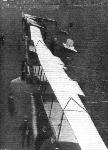 |
Журнал - Flight за 1912 г.
|
| Competitors ready for the second heat of the Speed Contest at Hendon last Saturday. - Reading from front to back: Messrs. Grahame-Whlte and R. Gates (H. Farman), Sydney Pickles (Caudron), Marcel Desoutter (Bleriot), and Sabelli (Hanriot).
|
 |
Журнал - Flight за 1914 г.
|
| A start for a cross-country race at Hendon Aerodrome with the opening of the present season.
|
 |
Журнал - Flight за 1914 г.
|
| THE START FOR THE AERIAL DERBY AT HENDON AERODROME. - Filip Bjorkland running his engine on his Bleriot just prior to getting away.
|
 |
P.Lewis - British Racing and Record-breaking Aircraft /Putnam/
|
| The start of the Aerial Derby at Hendon on 6 June, 1914. A Bleriot XI taxies away, with a Maurice Farman Longhorn waiting to follow.
|
 |
Журнал - Flight за 1911 г.
|
| HOLDING BACK A 100-H.P. BLERIOT MONOPLANE. - An "incident" in the successful attempt by Mr. Claude Grahame-White at Belmont Park Meeting, U.S.A., last year, to secure for Great Britain the Gordon-Bennett International Trophy.
|
 |
Журнал - Flight за 1911 г.
|
| DAILY MAIL CIRCUIT OF BRITAIN. - The two first off from Brooklands. At the top,"Beaumont" (Lieut. Conneau) on his Bleriot, and below, Mr. H. J. D. Astley on his Birdling monoplane.
|
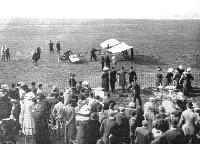 |
Журнал - Flight за 1912 г.
|
| Mr. B. C. Hucks getting away for an exhibition flight on Saturday last at Hendon.
|
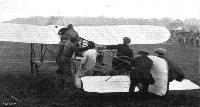 |
Журнал - Flight за 1912 г.
|
| Gustav Hamel just off on his 50-h.p. Bleriot for his great altitude flight.
|
 |
P.Jarrett - Pioneer Aircraft: Early Aviation Before 1914 /Putnam/
|
| Tom Sopwith runs up the 70hp Gnome rotary engine his new Bleriot XI two-seater on Long Island in the USA on 10 May 1911, the day it was wrecked in a crash without injuring its two occupants. Apart from the risk of damage, the practice of using a gang of men to restrain an aircraft imposed unquantifiable stresses on the structure.
|
 |
Журнал - Flight за 1914 г.
|
| Mr. S. Summerfield about to start on a flight at Melton Mowbray on his Bleriot. Note the little mascot cat above the wings.
|
 |
Журнал - Flight за 1911 г.
|
| EUROPEAN CIRCUIT. - Two great heroes on the starting line at Vincennes - Garros and Beaumont. The latter (No. 12) is just receiving the signal to get away, his companion following him at the next starting interval.
|
 |
Журнал - Flight за 1911 г.
|
| CIRCUIT OF BRITAIN. - Hamel leaving Chryston on his Bleriot.
|
 |
Журнал - Flight за 1912 г.
|
| THE DUBLIN-BELFAST AEROPLANE CONTEST. - Mr. H. J. D. Astley getting away on his 70-h.p. Bleriot from Leopardstown, Dublin.
|
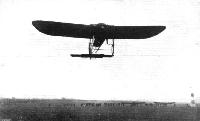 |
Журнал - Flight за 1912 г.
|
| Mr. B. C. Hucks getting off on the Gnome-BIeriot at Hendon on Saturday.
|
 |
Журнал - Flight за 1914 г.
|
| A sharp rise by Mr. B. C. Hucks on his Bleriot during his recent visit to Leicester for exhibition flying.
|
 |
Журнал - Flight за 1912 г.
|
| IN THE AIR DURING THE EASTER FLYING MEET AT HENDON. - Mr. B. C. Hucks on his 50 h.p. Bleriot
|
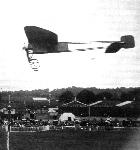 |
Журнал - Flight за 1912 г.
|
| Mr. B. C. Hucks in his Bleriot passing the Judges' box on the first circuit in the Hendon cross-country handicap last Saturday week.
|
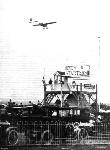 |
Журнал - Flight за 1912 г.
|
| Mr. B. C. Hucks, on a Gnome-Blerlot, passing before the Judges' box at Hendon on Saturday last.
|
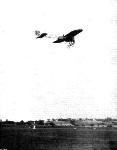 |
Журнал - Flight за 1912 г.
|
| Mr. Gustav Hamel on his Bleriot in the cross-country contest at Hendon last Saturday.
|
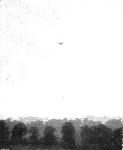 |
Журнал - Flight за 1912 г.
|
| Hamel, on his Bleriot, leaving Epping behind in his flight in the First Aerial Derby, as photographed from the top of Epping Tower.
|
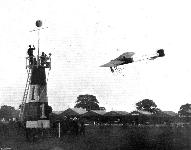 |
Журнал - Flight за 1912 г.
|
| Marcel Desoutter flying at the London Aerodrome, Hendon.
|
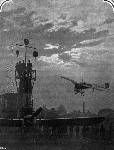 |
Журнал - Flight за 1913 г.
|
| A BEAUTIFUL SUNSET PICTURE AT THE HENDON AERODROME. - Mr. W. L. Brock passing No. 1 pylon on his Bleriot during a race.
|
 |
Журнал - Flight за 1913 г.
|
| ANOTHER CLOSE-RANGE PHOTOGRAPH OF A MACHINE IN FLIGHT. - Mr. Brock, on the Bleriot, passing No. 1 pylon at the Hedon Aefodrome.
|
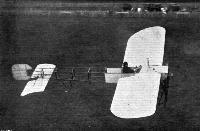 |
Журнал - Flight за 1912 г.
|
| In the above picture the single-seater Bleriot appears to be standing on the ground. As a fact, it is Mr. Gustav Hamel on his new single-seater flying quite low at a speed of between 50 and 60 miles an hour past No. 1 pylone.
|
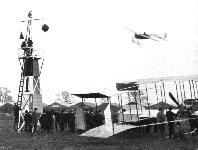 |
Журнал - Flight за 1912 г.
|
| Gustav Hamel rounding pylone No. 1 during a race at Hendon Spring Meeting.
|
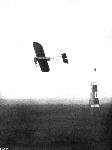 |
Журнал - Flight за 1913 г.
|
| Mr. Gustav Hamel making one of his banked turns at the Hendon Aerodrome.
|
 |
Журнал - Flight за 1914 г.
|
| Sopwith on his Bleriot, the first man back to the London Aerodrome on Saturday, June 8th, 1912, in the First Aerial Derby, who, however, was disqualified for passing inside the Purley control.
|
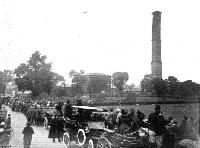 |
Журнал - Flight за 1912 г.
|
| THE FIRST AERIAL DERBY. - At Kempton Park turning point, showing Sopwith's Bleriot passing round the big shaft at Kempton Park which marked the limit of the course. The congestion of traffic with sightseers watching the flyers, as seen in the photograph, was practically the same completely around the entire course.
|
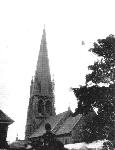 |
Журнал - Flight за 1912 г.
|
| Mr. B. C. Hucks, on his 70-h.p. Bleriot, circling round the steeple of Widford Church on Thursday last week, and dropping confetti as Mr. Claude Grahame-White and his bride were leaving the church after the ceremony.
|
 |
Журнал - Flight за 1912 г.
|
| Guests at Mr. Claude Grahame-White's wedding at Sir Daniel Gooch's residence, "Hylands," watching Mr. B. C. Hucks flying on his Bleriot during the afternoon. On the ground in front of the mansion is Mr. Grahame-White's Howard Wright biplane on which he flew over, and on the right is the Aircraft Co.'s Maurice Farman biplane on which M. Verrier during the afternoon gave some remarkable exhibitions in a strong wind.
|
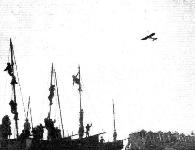 |
Журнал - Flight за 1912 г.
|
| Brighton youths determined to get a good view of Salmet during his flights in his Bleriot monoplane at Brighton recently. During all the visits of the aviators to various places, no point of vantage has ever been left vacant by the watchers of the entertainment.
|
 |
Журнал - Flight за 1913 г.
|
| MARCEL DESOUTTER FLYING AT HENDON ON SUNDAY. - At an altitude of 2,000 ft. the oil pipe of his engine broke away, and a dive, heading a 45-mile wind, resulted in a parachute-like dessent in perfect safety, but taking several minutes to finish. Our picture shows Desoutter on his Bleriot starting to climb.
|
 |
Журнал - Flight за 1913 г.
|
| FROM PAU TO MADRID BY AEROPLANE. - The journey of Bider on his Bleriot on Friday last week, when he flew from Pont Long Aerodrome, starting at 7.19 a.m., crossed the Pyrenees, arriving at Guadalajara, where he alighted at 12 o'clock noon, re-starting from there at 1 p.m., and reaching the Quatre-Vents Aerodrome, Madrid, at 130 p.m., a distance of about 500 kiloms. in 5 hrs. 11 mins. Our picture shows M. Bider over the Pyrenees in the vicinity of the Pic du Midi d'Ossan.
|
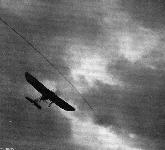 |
Журнал - Flight за 1912 г.
|
| A SUNSET FLYING EPISODE AT HENDON. - Hamel on his Bleriot.
|
 |
Журнал - Flight за 1913 г.
|
| AT THE BURTON FLYING MEETING. - Sydney Pickles, in his Bieriot
|
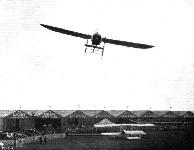 |
Журнал - Flight за 1913 г.
|
| A good picture of B. C. Hucks giving exhibition flights at Hendon on Saturday.
|
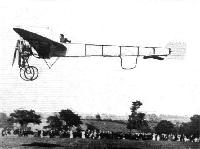 |
Журнал - Flight за 1913 г.
|
| Mr. S. Summerfield, flying at Melton Mowbray during the past season on his Bleriot machine, with which he has done a lot of work in the district.
|
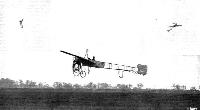 |
Журнал - Flight за 1913 г.
|
| LOOPING THE LOOP. - Mr. B. C. Hucks just off on his Bleriot for his looping demonstrations. Inset on the left he is seen going up on the first part of the loop. On the right, inset, he is seen actually upside down during the looping.
|
 |
Журнал - Flight за 1912 г.
|
| The incident of Mr. Gustav Hamel flying at Hendon Aerodrome round one of the balloons which had just before started from Hurlingham in connection with the Royal Aero Club balloon race for the Hedges Butler cup. This photograph was secured at about two miles distance, and by way of comparison, inset is a contact print from the original negative, the enlargement being untouched.
|
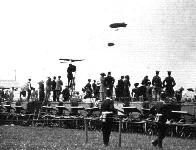 |
Журнал - Flight за 1913 г.
|
| THE PARADE AT LAFFAN'S PLAIN ON THE KING'S BIRTHDAY. - The "Gamma" and "Beta" in the air together, and the I.C.S. Bleriot circling round them.
|
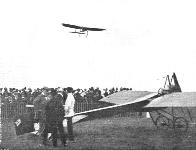 |
Журнал - Flight за 1912 г.
|
| Marcel Desoutter piloting No. 6 Bleriot in the Hendon Aerodrome competitions.
|
 |
Журнал - Flight за 1912 г.
|
| FLYING AT THE NANCY AVIATION FETE. - A fine natural grand stand. Kuhling on his Bleriot monoplane, and Loridan on a Henry Farman machine, are seen in flight.
|
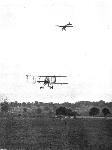 |
Журнал - Flight за 1912 г.
|
| MONOPLANE VERSUS BIPLANE AT THE LONDON AERODROME, HENDON. - Mr. Lewis Turner on the Grahame-White 'bus and Mr. Hall on a Bleriot monoplane.
|
 |
Журнал - Flight за 1913 г.
|
| AN AIR GREETING AT HENDON ON SATURDAY AFTERNOON. - Desoutter, on a Blerlot, passing under and waving his hand to Manton on the Grahame-White biplane.
|
 |
Журнал - Flight за 1913 г.
|
| A Hanriot monoplane arriving at Hendon from Brooklands to take part in a competition while one of its future competltors - a Bleriot - is in the air.
|
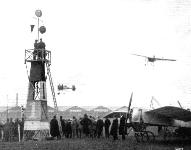 |
Журнал - Flight за 1913 г.
|
| Gustav Hamel, on his Bleriot, and M. Richet, on the Breguet, during the race at Hendon for the Aero Show Trophy.
|
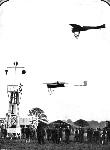 |
Журнал - Flight за 1913 г.
|
| A close finish for second place in the "Shell" Handicap at Hendon on Saturday between Lieut. Porte on the Deperdussin and Mr. R. Slack on the Blerlot.
|
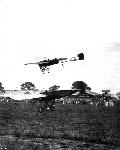 |
Журнал - Flight за 1913 г.
|
| A remarkable photographic record of an incident in the International contest at Hendon on Saturday. - Brock on the Bleriot winning by a few feet only from Marty on the Morane-Saulnier, who flew underneath him as they crossed the line.
|
 |
Журнал - Flight за 1914 г.
|
| Louis Noel on the Bleriot overtaking Louis Strange flying the Grahame-White Boxkite during a race at Hendon on 14 March, 1914.
|
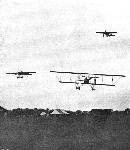 |
Журнал - Flight за 1912 г.
|
| Remarkable flying was seen in the Speed Handicap at Hendon on Saturday. Our photograph shows, on the left, Jules Nardini on the Deperdussin, on the right Pierre Verrier on the Maurice Farman, and above, Marcel Desoutter, on the Bleriot, just about to enter on the last lap.
|
 |
Журнал - Flight за 1912 г.
|
| A TRIO. - Finish of first heat of the Speed Handicap at Hendon, Saturday, the competitors being Mr. Gustav Hamel, Mr. J. L. Travers, and Mr. Sabelli in the order named.
|
 |
Журнал - Flight за 1914 г.
|
| RACING AT HENDON. - The second heat of the Speed Handicap on Whit Saturday. From left to right the machines are: Messrs. R. J. Lillywhite (G.-W. twin rudder), Verrier (Maurice Farman), W. Birchenough (G.-W.-Maurice Farman), and L. Noel (Bleriot).
|
 |
Журнал - Flight за 1911 г.
|
| PARIS-ROME. - "Beaumont" (Lieut. Conneau) arriving at the Rome Aerodrome.
|
 |
Журнал - Flight за 1911 г.
|
| CIRCUIT OF BRITAIN. - Lieut. Conneau ("Beaumont") finishing on his Bleriot and winning the L10,000 at Brooklands on Wednesday, July 26th.
|
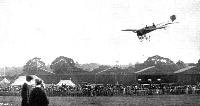 |
Журнал - Flight за 1912 г.
|
| The return en vol plane to the Hendon aerodrome by Mr. Hamel and Miss Trehawke Davies, after winning the Altitude Competition at the Whitsun Meeting.
|
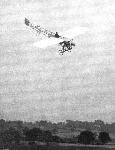 |
Журнал - Flight за 1912 г.
|
| Mr. Gustav Hamel executing one of his very impressive vol planes at Hendon.
|
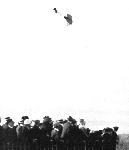 |
Журнал - Flight за 1912 г.
|
| MR GUSTAV HAMEL BACK AGAIN AT HENDON. - In our picture he is seen on his Bleriot executing one of his halr-raising corkscrew vol planes at last Saturday's meeting at the London Aetodrome.
|
 |
Журнал - Flight за 1913 г.
|
| FLYING AT RANELAGH. - M. Gustav Hamel just before landing at Ranelagh last Week, after one of his exhibition flights.
|
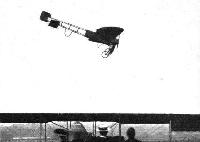 |
Журнал - Flight за 1912 г.
|
| Mr. H. J. D. Astley finishing a straight vol plane from a height of about 2,000 ft. at Hendon on Saturday last.
|
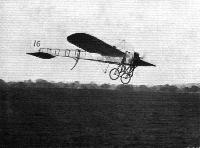 |
Журнал - Flight за 1912 г.
|
| Mr. B. C. Hucks, on his Blerlot, landing after making an altitude record for this year of 6,850 ft. at Hendon Aerodrome.
|
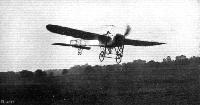 |
Журнал - Flight за 1913 г.
|
| THE FINISH OF A FINE FLIGHT AT HENDON. - Mr. B.C. Hucks descending after his attempt to beat the British altitude record, when he reached 9,800 ft.
|
 |
A.Imrie - German Naval Air Service /Arms & Armour/
|
| This Bleriot monoplane landing on the Zeebrugge Mole was captured from the Belgian forces during the German advance in Planders. It was allocated the official naval landplane serial number S 96 and was in continuous use until autumn 1915, when its 80hp Gnome rotary engine was 'redirected' to power one of the new Fokker E monoplanes, engines for which were in short supply.
|
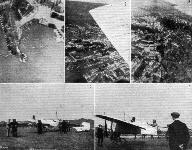 |
Журнал - Flight за 1913 г.
|
| MR. CORBETT WILSON IN SWITZERLAND. - Above are three views of (1) Ouchy, (2) Lausanne Station, (3) general view of Lausanne taken by Capt. Friedrich when passenger with Mr. Wilson; below (4) some of the Swiss officers who went as passengers with Mr. Wilson in conversation with him; and on the right (5) Capt. Instructor Lederry just about to take a flight with Mr. Wilson. - Suisse Sportive.
|
 |
Журнал - Flight за 1913 г.
|
| Some snaps from M. Salmet's Bleriot at Scarborough from about 2,000 ft. up, taken by Mr. A. J. A. Wallace Barr recently. The centre photograph and the left show the Grand Hotel and foreshore from different points, and on the right is seen the railway station.
|
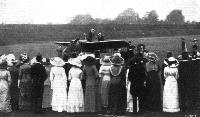 |
Журнал - Flight за 1912 г.
|
| THE KING AND AVIATION. - Mr. Gustav Hamel and Capt. Mark Kerr, R.N., immediately after their arrival at Ranelagh last week, when Mr. Hamel flew before the King and Queen. Mr. Hamel and his passenger are seen, before actually alighting from the machine - a Bleriot - in which they flew over from Hendon, using it as a "dressing room" by shedding their flying rig in favour of more suitable attire for the occasion.
|
 |
Журнал - Flight за 1911 г.
|
| AVIATION AT THE FRENCH ARMY MANOEUVRES. - Some of the Bessonneau hangars at Vesoul, and the military aeroplanes which are giving such a splendid account of themselves.
|
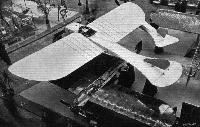 |
Журнал - Flight за 1911 г.
|
| THE BLERIOT STAND. - At the bottom of the picture, with the warnished wings, is the new "Popular" type Bleriot, fitted with a Y-type Anzani motor of 35-h.p. as listed at L380. The larger monoplane is the 70-h.p. military two-seater, while the tail-half of a machine emerging from under the right wing of the two-seater belongs to the new 50-h.p. Racer.
|
 |
Журнал - Flight за 1912 г.
|
| Showing the method of mounting one of the new 35-h.p. Y-type Anzani motors in a Bleriot monoplane. The photographs are of Mr. Prenseill's Bleriot at Hendon,
|
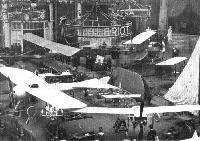 |
Журнал - Flight за 1912 г.
|
| Representative stand at the Salon - the Bleriot.
|
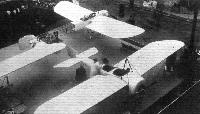 |
Журнал - Flight за 1913 г.
|
| Two of the monoplanes on the Bleriot stand at the Paris Salon.
|
 |
Журнал - Flight за 1912 г.
|
| A military aeroplane dismantled ready for transportation in tne special aviation wagon which has been constructed for military manoeuvres in France. This wagon, immediately the aeroplane is safely housed, is in a few minutes attached to a fore-carriage, and is then ready to be hauled anywhere by the horses.
|
 |
Журнал - Flight за 1913 г.
|
| THE BLERIOT MONOPLANE TRANSPORTER. - The top picture shows the transporter folded up and in tow on a pair of its own wheels behind a car; that on the left illustrates the transporter in action, carrying a Bieriot tandem two-seater monoplane. An idea of its construction can be gathered from the right-hand photograph, which shows how the transporter, which can be towed by means of horses or automobile, can be driven over obstacles without upsetting; the balance of the monoplane on board.
|
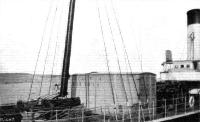 |
Журнал - Flight за 1913 г.
|
| The military Bleriot machine, which Mr. Gustav Hamel flew from Dover to Cologne last week, arriving in its packing case at Dover from France, prior to the achievement.
|
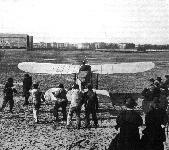 |
Журнал - Flight за 1912 г.
|
| THE RECORD NON-STOP HENDON TO PARIS FLIGHT OF MR. SALMET. - Mr. Salmet, on his Bleriot monoplane, at the moment of being released at Issy grounds, for the return journey to London, after his remarkable flight from Hendon in a little over three hours.
|
 |
Журнал - Flight за 1912 г.
|
| SALMET'S PARIS FLIGHT. - On the left his Bleriot monoplane pegged down for the night at Berck Plage, near Dieppe. Note the cut-away wings, the covered-in fuselage forming a float, and the Entente Cordiale emblem on the rudder. On the right is seen the moment of his start from Berck Plage the following morning.
|
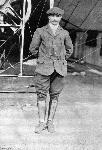 |
Журнал - Flight за 1912 г.
|
| MR. HENRI SALMET, The chief instructor of the Bleriot School at Hendon, who made the record nonstop flight from Hendon to Paris on March 7th on a 50-h.p. Gnome-engined Bleriot monoplane, his time being 3 hrs. 16 mins.
|
 |
Журнал - Flight за 1911 г.
|
| Mr. Frank L. Champion with Radley's old Gnome-Bleriot monoplane, on which he is now flying at Los Angeles, South California. Champion, it will be remembered, was a pupil of the Bleriot School at Hendon.
|
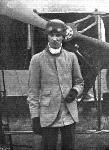 |
Журнал - Flight за 1912 г.
|
| Mr. H . J. D. Astley, one of our finest English aviators, who has recently been again flying so splendidly.
|
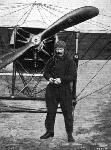 |
Журнал - Flight за 1912 г.
|
| Mr. Robert Slack, the I.C.S. pilot, in front of his Bleriot machine, upon which he on Sunday completed at Hendon his 1,000 miles tour through the Midlands.
|
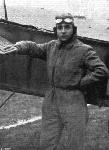 |
Журнал - Flight за 1912 г.
|
| M. Marcel Desoutter, one of the crack flyers at the London Aerodrome, Hendon.
|
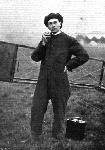 |
Журнал - Flight за 1912 г.
|
| Mr. J. L. Hall, who is putting in such good work on his Bleriot at Hendon, and who has just obtained his pilot certificate at the Bleriot School.
|
 |
Журнал - Flight за 1912 г.
|
| THE MILITARY COMPETITION MACHINES. - One of the actual Bleriots that will take part int he trials.
|
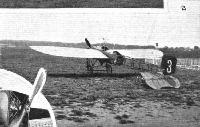 |
Журнал - Flight за 1912 г.
|
| THE MILITARY COMPETITION MACHINES. - Three-quarter rear view of Hamel's 70-h.p. 2-seater Bleriot, an almost identical machine.
|
 |
Журнал - Flight за 1913 г.
|
| The single-seater Bleriot.
|
 |
Журнал - Flight за 1912 г.
|
| THE MILITARY COMPETITION MACHINES. - The machine as seen from in front.
|
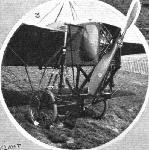 |
Журнал - Flight за 1912 г.
|
| THE MILITARY COMPETITION MACHINES. - Detailed view of the chassis and front section of the machine.
|
 |
Журнал - Flight за 1912 г.
|
| THE MILITARY COMPETITION MACHINES. - The tail.
|
 |
Журнал - Flight за 1914 г.
|
| The two-seater Bleriot Monoplane (No. 6).
|
 |
M.Goodall, A.Tagg - British Aircraft before the Great War /Schiffer/
|
| Bleriot XI-2. The two-seater.
|
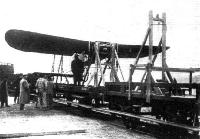 |
Журнал - Flight за 1912 г.
|
| The Bleriot under test, seen from in front.
|
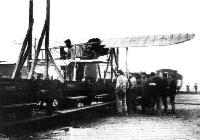 |
Журнал - Flight за 1912 г.
|
| The Bleriot under test, on the railway.
|
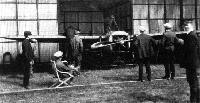 |
Журнал - Flight за 1912 г.
|
| THE MILITARY AVIATION TESTS. - Assembling machines under observation. One of the Bleriot monoplanes being put together.
|
 |
Журнал - Flight за 1912 г.
|
| WEIGHTING THE MACHINES IN THE ARMY TESTS. - The aeroplane undergoing the operation is No. 4, a Bleriot.
|
 |
Журнал - Flight за 1914 г.
|
| In connection with M. Bieriot's candidature for the Seine General Council, as we mentioned last week, Bleriot monoplanes were utilised for the dissemination of handbills and other election literature on behalf of M. Bleriot. Above is seen one of the machines used at Buc, on the left being M. Bleriot and in the pilot's seat M. A. Bidot, who piloted this 80 h.p. military machine in a 90 kilometre wind, the handbills being thrown out by Mr. T. Elder Hearn, who is also seen in the above machine.
|
 |
Журнал - Flight за 1914 г.
|
| Tandem two-seater Bleriot.
|
 |
J.Forsgren - Swedish Military Aircraft 1911-1926 /Centennial Perspective/ (68)
|
| Carl Cederstrom in front of one of his Bleriot XI's at Malmen. Via www.digitaltmuseum.se
|
 |
J.Forsgren - Swedish Military Aircraft 1911-1926 /Centennial Perspective/ (68)
|
| Photographed at the Thulin flying school at Ljungbyhed, this particular Thulin A consisted of parts from an original AFK Bleriot XI. Via Arlanda Flygsamlingar
|
 |
J.Forsgren - Swedish Military Aircraft 1911-1926 /Centennial Perspective/ (68)
|
| The AVIS-built Bleriot XI later became serial number 7 with the AFK. Via Swedish Aviation Historical Society
|
 |
Журнал - Flight за 1913 г.
|
| Two views of Mr. Vivian Hewitt's Bleriot in its latest form.
|
 |
Журнал - Flight за 1913 г.
|
| On the left the top cabane, and on the fight showing the engine shield and doors removed. They can be taken off and replaced very quickly.
|
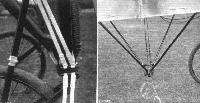 |
Журнал - Flight за 1913 г.
|
| On the left Mr. Hewitt's method of attaching the four ribbons to the bracket is shown, while on the right is the new warping cabane. Note the bracing and steel wheels and the thick wires to the cloche.
|
 |
Журнал - Flight за 1914 г.
|
| The above snaps are of considerable historical interest from the fact that they show the scene at Buc uoon the occasion when Pegoud for the first time "looped the loop" on his Bleriot. On the left Pegoud is seen pointing out to those concerned the exact spot where he Intended to make his first loop. In the centre picture is the late M. Perreyon, and in the righ-hand picture from right to left MM. Pegoud, Domenjoz and Perreyon.
|
 |
Журнал - Flight за 1915 г.
|
| Another reminiscence of the late Second Lieut. Pegoud. - Pegoud, in September, 1913, starting a Bleriot belonging to M. Bleriot at Hardelot, where the famous builder of these aeroplanes has a villa.
|
 |
L.Opdyke - French Aeroplanes Before the Great War /Schiffer/
|
| One of Pegoud's Type XIs, this one fitted with the parachute with which he made at least one successful jump in 1913; note the inverted rudder to make room for the opening parachute. His machines featured a taller cabane pylon, needed in his looping experiments.
|
 |
L.Opdyke - French Aeroplanes Before the Great War /Schiffer/
|
| At least one of Pegoud's XIs had a one-piece elevator, the 2 halves connected with the elevator spar. Note their reverse curve, and the added extensions at the ends.
|
 |
Журнал - Flight за 1913 г.
|
| A back view of Pegoud in his Bleriot just at the moment of starting at Brooklands for one of his flights showing him strapped in to his seat, and also the tail as fitted to his Bleriot.
|
 |
Журнал - Flight за 1915 г.
|
| Reminiscences of the late Second Lieut. Pegoud. - Pegoud just making his start for Paris in his Bleriot, September, 1913.
|
 |
Журнал - Flight за 1913 г.
|
| PEGOU'S EXTRAORDINARY FLIGHTS. - Three untouched photographs of bis upside down flying. In the centre: diving for the turn. On the left: turning over. On the rights upside down.
|
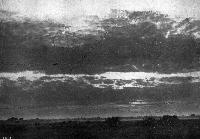 |
Журнал - Flight за 1913 г.
|
| A LOVELY SUNSET AT BROOKLANDS. - In the air, M. Pegoud returning from one of his remarkable flights.
|
 |
Журнал - Flight за 1916 г.
|
| AT HENDON. - In 19-- it may be that pilots will vol plane into Mitchell's tea gardens for the cup that cheers. The one shown was probably only on a reconnaissance trip. The Bleriot, in the shade of whose wings the tables are set, is that of the late G. Lee Temple.
|
 |
J.Herris - Friedrichshafen Aircraft of WWI /Centennial Perspective/ (21)
|
| The circumstances of this photo are unknown, but the robust Friedrichshafen G.IIIa dwarfs the fragile Bieriot.
|
 |
Журнал - Flight за 1914 г.
|
| THREE HISTORIC MACHINES IN LINE AT HELIOPOLIS. - In the centre is Marc Pourpe's 60 h.p. Gnome-Morane-Saulnier, which he flew from Cairo to Khartoum and is now flying back - this is the identical machine on which Garros crossed the Mediterranean on the left is Vedrines 80 h.p. Gnome Bleriot which was flown from Paris to Cairo; while on the right is Bonnier's 80 h.p. Gnome-Nieuport, which has also been flown from Paris to Cairo.
|
 |
Журнал - Flight за 1914 г.
|
| Two Bedouin watchmen, known locally as Gafirs, on guard over Mr. W. Oswald Watts' Bleriot at Heliopolis.
|
 |
Журнал - Flight за 1914 г.
|
| FLYING AT HELIOPOLIS. - The first Hangar in Egypt to fly the British flag. The machine in front is Mr. W. Oswald Watts' 60 h.p. Blerlot single-seater, and behind inside may be noticed Marc Pourpe's Khartoum 60 h.p. Morane-Saulnier on which, half an hour after the photograph was taken, he started away and flew to Suez in 1 hr. 10 mins., very fine going.
|
 |
Журнал - Flight за 1914 г.
|
| A couple of interior views of the new British Bleriot works at Brooklands. On the left a view of half a dozen machines in the shop, and on the right a portion of the wood-working department is seen.
|
 |
J.Davilla - Italian Aviation in the First World War. Vol.1: Operations /Centennial Perspective/ (73)
|
| Bleriots under construction in Italy.
|
 |
Журнал - Flight за 1915 г.
|
| Lieut. Gran transporting his Bleriot by road in the Arctic regions of Norway. - The driver is typical of that part of the country.
|
 |
Журнал - Flight за 1915 г.
|
| Lieut. Gran on board the steamer with his Bleriot at the moment of crossing the Arctic circle.
|
 |
Журнал - Flight за 1913 г.
|
| Pilot: Mr. G. Lee Temple.
|
 |
Журнал - Flight за 1913 г.
|
| Pilot: Mr. W. L. Brock.
|
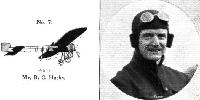 |
Журнал - Flight за 1913 г.
|
| Pilot: Mr. B. C. Hucks.
|
 |
Журнал - Flight за 1914 г.
|
| Pilot: Mr. L. A. Strange.
|
 |
K.Delve - World War One in the Air /Crowood/
|
| The Bleriot XI was built in five principal versions and was in military use from 1910 - equipping a number of French squadrons by the outbreak of War. It also served with the Italian and British (as here) air arms.
|
 |
В.Кондратьев - Самолеты первой мировой войны
|
| Русский "Блерио-XI Милитэр", октябрь 1916 г. К началу мировой войны примитивность конструкции Блерио B-XI стала очевидной.
|
 |
P.Grosz, G.Haddow, P.Shiemer - Austro-Hungarian Army Aircraft of World War One /Flying Machines/
|
| The Bleriot IX trainer (60 hp Gnome) was attached to the Fliegeroffiziersschule in Wiener-Neustadt in 1917. Although no serial number is visible, it is believed to be machine 00.02.
|
 |
O.Thetford - British Naval Aircraft since 1912 /Putnam/
|
| The Bleriot Type XI-2 Artillerie, as its name implies, was employed on reconnaissance for the artillery and entered service with the French and Italians during 1911. At the outbreak of war, this 70hp Gnome-engined two seater was in service with the French, Britain's RFC and RNAS, Belgium and Italy. Its relatively meagre top level speed of 66mph at sea level was no great problem at a time when effective anti-aircraft artillery or fighters were yet to make an appearance, while its 3.5 hour endurance provided a useful time aloft.
|
 |
Jane's All The World Aircraft 1919 /Jane's/
|
| Type XI-2. Standard "tandem" military monoplane developed from the single-seat Type XI. Bleriot monoplane used (alongside a B.E.2a) on the very first RFC reconnaissance over German lines, 19 August 1914.
|
 |
J.Davilla - Italian Aviation in the First World War. Vol.2: Aircraft A-H /Centennial Perspective/ (74)
|
| Italian Bleriot 11 Bl.173 in service.
|
 |
J.Davilla - Italian Aviation in the First World War. Vol.2: Aircraft A-H /Centennial Perspective/ (74)
|
| Bleriot 11 escadrille in French service; all the aircraft are two-seaters.
|
 |
J.Davilla - Italian Aviation in the First World War. Vol.2: Aircraft A-H /Centennial Perspective/ (74)
|
| Italian Bleriot 11 '17' in service.
|
 |
J.Davilla - Italian Aviation in the First World War. Vol.2: Aircraft A-H /Centennial Perspective/ (74)
|
| Bleriot 11s in Italian service.
|
 |
J.Davilla - Italian Aviation in the First World War. Vol.2: Aircraft A-H /Centennial Perspective/ (74)
|
| Italian Bleriot 11s at war. (Roberto Gentilli)
|
 |
K.Delve - World War One in the Air /Crowood/
|
| Of the other early designs, the Bleriot XI was of particular note and was yet another French type to be used by the British. It was also a long-lived type serving on into 1916 (as with this RNAS example that was delivered in January 1916 by which time they were primarily used for training).
|
 |
Журнал - Flight за 1912 г.
|
| View of the controls on Ovington's Bleriot monoplane.
|
 |
Журнал - Flight за 1911 г.
|
| LONDON TO PARIS FLIGHT. - Above is M. Prier in his seat, with route map in front of him, just before his start from Hendon; and below is M. Prier's Gnome-engined Bleriot having its final testing immediately before the start for this record journey last week.
|
 |
Журнал - Flight за 1911 г.
|
| M. Prier, with Mrs. Gordon Jones, a pupil at the Bleriot School of Aviation at Hendon, in the passenger seat, just about to get away for a flight.
|
 |
Журнал - Flight за 1911 г.
|
| M. Roland Garros, who last week put up a new altitude record on a Bleriot monoplane of 13,943 feet at Parame, near St. Malo.
|
 |
Журнал - Flight за 1911 г.
|
| Lieut. R. A. Cammell, the distinguished Array aviator who was killed at Hendon on Sunday last.
|
 |
Журнал - Flight за 1911 г.
|
| MR. W. B. R. MOORHOUSE. Who has recently been making such excellent cross-country flights on his Gnome-Blerlot from Portholme Aerodiome, Huntingdon, to Northampton and the district, and on Friday from Huntingdon to Brooklands.
|
 |
Журнал - Flight за 1912 г.
|
| Mr. Gustav Hamel at the wheel of his 70-h.p. Bleriot with which he made his splendid altitude flight at Hendon. Inset Mr. Hamel is seen during one of his fine bankings.
|
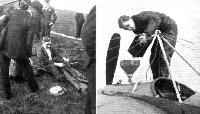 |
Журнал - Flight за 1912 г.
|
| Mr. Hamel preparing for his altitude flight on the Blerlot at the Hendon Whitsun Meeting by donning his new leather overalls and replenishing his tank.
|
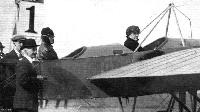 |
Журнал - Flight за 1912 г.
|
| Mr. Hamel and Miss Trehawke Davies in the two-seater Bleriot at the Hendon Meeting, ready for the Altitude Competition. Standing on the left is Mr. N. Chereau, the British chief of Bleriots.
|
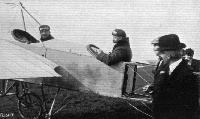 |
Журнал - Flight за 1913 г.
|
| Gustav Hamel takes Sir Joseph Ward for a flight in the "Britannia" at Hendon after its christening.
|
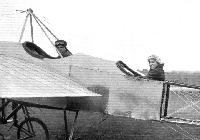 |
Журнал - Flight за 1913 г.
|
| Mr. Gustav Hamel just about to start for a flight with Miss Teddie Gerrard, on the Hippodrome, at Brooklands on Sunday last. Mr. Hamel climbed to nearly 9,000 ft., and in descending stopped his propeller at 6,000 ft.
|
 |
Журнал - Flight за 1913 г.
|
| SUNDAY FLYING A T BROOKLANDS. - Mr. Gustav Hamel gives our photographic artist a "sitting" whilst Miss Teddie Gerrard looks on innocent of the fact that she is included on the plate.
|
 |
Журнал - Flight за 1914 г.
|
| Miss Trehawke Davies handing Mr. Gustav Hamel his goggles prior to ascending with Mr. Hamel in his monoplane at Hendon on Friday, January 2nd, for the purpose of looping the loop, Miss Davies being the first woman to go through this remarkable experience in Great Britain.
|
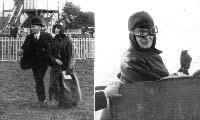 |
Журнал - Flight за 1912 г.
|
| Miss Trehawke Davies, who has done so much crosscountry flying with Mr. Hamel, crossing the flying ground at Hendon at the Whitsun Meeting for Mr. Hamel's flight in the Altitude Competition. On the right, Miss Davies is in the passenger's seat of the Bleriot.
|
 |
Журнал - Flight за 1914 г.
|
| MISS TREHAWKE DAVIES.
|
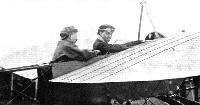 |
Журнал - Flight за 1912 г.
|
| SOME OF THE HENDON PILOTS. - At the top Mr. T. O. M. Sopwith and Mr. Sasscon on Mr. Sopwith's 70-h.p. Bleriot.
|
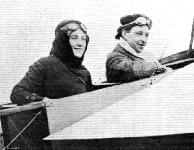 |
Журнал - Flight за 1912 г.
|
| Mr. T. O. M. Sopwith, the winner of the flying handicap on Sunday from Brookiands to Chertsey Bridge and back, with his lady passenger who accompanied him.
|
 |
Журнал - Flight за 1912 г.
|
| Mr. Vivian Hewitt and his Bleriot monoplane on the shore at Foryd, North Wales, where he has been making his fine flights for the past few months. Mr. Hewitt, at the time of writing, is waiting in the hope of flying the lrish Channel.
|
 |
Журнал - Flight за 1914 г.
|
| Mr. Vivian Hewitt and his lamb passenger.
|
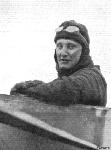 |
Журнал - Flight за 1912 г.
|
| Mr. D. L. Allen, the aviator who has been missing since last week, when he started upon his attempt to fly the Irish Channel.
|
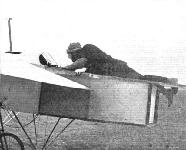 |
Журнал - Flight за 1912 г.
|
| Mr Allen, on his Bleriot, tuning up at Hendon last week before hts start for the Irish Channel flight, which has ended so mysteriously.
|
 |
Журнал - Flight за 1912 г.
|
| A snapshot of Hucks and his passenger, Mr. Harold Barlow, seated to the right, taken on Monday morning of last week just before they set out from Issy to fly to London on their new two-seater Bleriot.
|
 |
Журнал - Flight за 1912 г.
|
| Mr. B. C. Hucks and Mrs. Craig off for a flight at Hendon on the former's fast Bleriot.
|
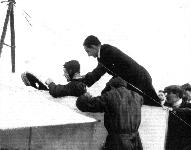 |
Журнал - Flight за 1913 г.
|
| Mr. B. C. Hucks before looping the loop at Hendon having his shoulder-straps fixed safely by his Manager, Mr. J. C. Savage.
|
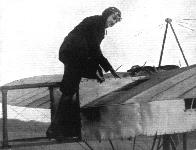 |
Журнал - Flight за 1912 г.
|
| Miss Bernetta Miller, an American aviatress, who has been flying a monoplane in America recently.
|
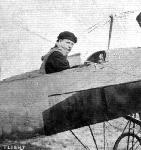 |
Журнал - Flight за 1913 г.
|
| Mr. D. W. Clappen, who took his brevet at the Bleriot School, Hendon, on August 15th.
|
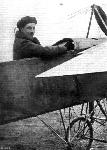 |
Журнал - Flight за 1913 г.
|
| Capt. Geoffrey Cox, 3rd North Staffordshire Regiment (Special Reserve), who has recently taken his certificate at the Bleriot School at Hendon.
|
 |
Журнал - Flight за 1914 г.
|
| Mr. T. Elder Hearn, who was just taken his brevet in France, after 4 hrs. 40 mins. work at the Bleriot School at Buc. He writes that after some further practice he intends to try the "loop" and thereby score a record for rapid advance in piloting, and hopes to follow it up immediately afterwards with a flight from Paris to London.
|
 |
Журнал - Flight за 1914 г.
|
| Mr. Salmet and his passenger, Mr. T. Elder Hearn, just before their flight from Buc to Hendon last week. Mr. Hearn hopes to make the same trip as pilot himself in about three weeks' time.
|
 |
Журнал - Flight за 1914 г.
|
| Marcel Desoutter, who is now flying again, about to leave Brooklands on Sunday last for Hendon on Lord Edward Grosvenor's Bleriot.
|
 |
Журнал - Flight за 1914 г.
|
| Mr. R. Skene in the pilot's seat of Lord Edward Grosvenor's Bleriot.
|
 |
Журнал - Flight за 1914 г.
|
| Mr. Landry, the first French Canadian to take his F.A.I. brevet at Buc.
|
 |
Журнал - Flight за 1914 г.
|
| OUR FLIGHT OFFICERS AT THE FRONT. - Lieut. James Valentine, R.F.C., with his Bleriot at ---.
|
 |
Журнал - Flight за 1914 г.
|
| Capt. Oswald Watt (now with the French Army) starting for a flight, with Mr. Wallace Barr as passenger, from the aerodrome at St. Cyr.
|
 |
Журнал - Flight за 1915 г.
|
| A snap in 70 degs. N. latitude of Lieut. Gran, taken by his passenger at an altitude of 3,000 feet. The machine is one of the Norwegian Royal Flying Corps' two-seater Bleriots, named Nordsjoen (North Sea).
|
 |
Журнал - Flight за 1913 г.
|
| A remarkable incident which occurred to Taddeoli on June 6th when flying from Berne to Bienne in Switzerland. One of the chassis wheels came off without his knowing anything about it, but Bider, who was at the aerodrome, at once started after him on his Bleriot, and by means of energetic dumb show managed to apprise Taddeoli of his danger, so that Taddeoli was able to land so carefully that no further damage of any sort occurred. - Suisse Sportiue.
|
 |
Журнал - Flight за 1915 г.
|
| A Unique Atterrissage. - A Bleriot come to rest on the upper wing of a Voisin biplane. The occupants of both machines were none the worse for this little incident.
|
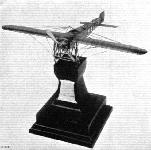 |
Журнал - Flight за 1913 г.
|
| The solid silver model of the Bleriot monoplane used by Mr. Gustav Hamel in his splendid flight from London to Cologne. This artistic work was designed and manufactured by Messrs. Mappin and Webb, and presented to Mr. Hamel by the British Petroleum Company ("Shell" motor spirit) at a banquet on June 5th.
|
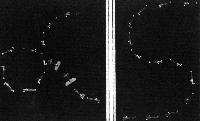 |
Журнал - Flight за 1913 г.
|
| PEGOUD'S RECENT FLIGHTS. - The above plates have been prepared by FLIGHT for the purpose of more graphically showing the evolutions which are performed by M. Pegoud when looping the loop and doing his "S" shaped upside down flight, and how he actually recovers his normal position. The diagrams are prepared by photography from a small model of the Bleriot.
|
 |
Журнал - Flight за 1915 г.
|
| A scale model Bleriot built by Mr. O. A. Woad, of South Dunedin, New Zealand.
|
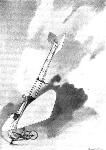 |
Журнал - Flight за 1913 г.
|
| Spiral vol plane by Hamel on 80-h.p. Blerlot, with Miss Trehawke Davies as passenger, May 3rd, on his return from a flight to Windsor, reaching an altitude of 7,000 ft. From a sketch by Roderic Hill.
|
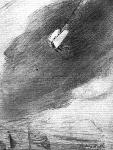 |
Журнал - Flight за 1913 г.
|
| LORD MAYOR'S DAY AT HENDON AERODROME. - An impression of Hamel by Roderick Hill.
|
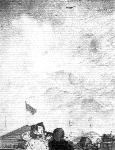 |
Журнал - Flight за 1913 г.
|
LORD MAYOR'S DAY AT HENDON AERODROME. - Up aloft. Another impression of Hamel by Roderick
Hill.
|
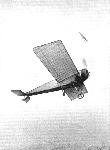 |
Журнал - Flight за 1913 г.
|
| "LADIES DAY" AT HENDON AERODROME. - The Morane-Saulnier and Bleriot circling round each other. From an original drawing by Roderlc Hill.
|
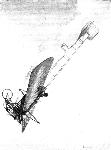 |
Журнал - Flight за 1913 г.
|
| THE FIRST ENGLISHMAN TO LOOP THE LOOP. - An impression of Mr. B. C. Hucks flying in an inverted position at Hendon Aerodrome on Saturday, November 29th, on a 50 h.p. Bleriot with reinforced wing bracing. From an original drawing by Mr. Roderic Hill.
|
 |
Журнал - Flight за 1915 г.
|
|
|
 |
Журнал - Flight за 1911 г.
|
| MONOPLANES AND BIPLANES IN THE DAILY MAIL CIRCUIT ROUND GREAT BRITAIN. - From these every machine can be readily identified either in flight or on the ground.
|
 |
Журнал - Flight за 1912 г.
|
|
|
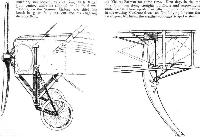 |
Журнал - Flight за 1912 г.
|
| Landing chassis and tall skid of Mr. Hucks' Bleriot, with which he has been making the Daily Mail flights so successfully.
|
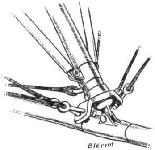 |
Журнал - Flight за 1912 г.
|
| The New Bleriot Chassis. - The fitting to which the front wing spars are stayed.
|
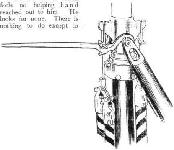 |
Журнал - Flight за 1912 г.
|
| A detail of the Bleriot military monoplane, showing the means whereby, using a special lever, the shock-absorbers can be disconnected, allowing the machine to be lowered on to its knees, as it were.
|
 |
Журнал - Flight за 1913 г.
|
| DETAILS OF THE BLERIOT MONOPLANE. - The sketch on the left shows the method of strengthening the bottom cross-plank of the landing chassis and the application of stranded cable. The middle sketch shows the upper wing staywire attachment. That on the right illustrates how the double control-wires are fastened to the rudder lever.
|
 |
Журнал - Flight за 1913 г.
|
|
|
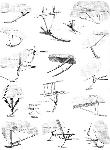 |
Журнал - Flight за 1913 г.
|
| AT OLYMPIA. - A study in tail-skids.
|
 |
Журнал - Flight за 1913 г.
|
| A study in tails.
|
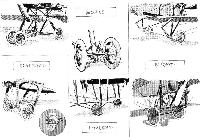 |
Журнал - Flight за 1915 г.
|
| Various French undercarriages.
|
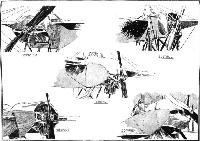 |
Журнал - Flight за 1916 г.
|
| Engines mounted between double bearers, and their housings.
|
 |
Журнал - Flight за 1913 г.
|
| The 80-h.p. Bleriot monoplane.
|
 |
Jane's All The World Aircraft 1913 /Jane's/
|
| 1913 type of XI bis. UAS.
|
 |
Журнал - Flight за 1913 г.
|
| The 80-h.p. Bleriot tandem monoplane.
|
 |
Журнал - Flight за 1914 г.
|
| The 70 h.p. Bleriot two-seater monoplane.
|
 |
J.Davilla - Italian Aviation in the First World War. Vol.2: Aircraft A-H /Centennial Perspective/ (74)
|
| Bleriot XI-2, Typical markings, 1914
|
 |
J.Davilla - Italian Aviation in the First World War. Vol.2: Aircraft A-H /Centennial Perspective/ (74)
|
| Bleriot XI-2, Typical markings, 1915
|
 |
В.Кондратьев - Самолеты первой мировой войны
|
| Bleriot-XI
|

